
13
Jan
(Beyond Pesticides, January 13, 2015) Over a decade after consumer opposition halted multinational agrichemical business Monsanto’s plans to develop genetically engineered (GE) herbicide-resistant wheat, the company is trying again. This time, Monsanto’s goal is to create wheat that is resistant to three different herbicides; glyphosate, glufosinate, and dicamba. Although over 90% of corn, soybean, and cotton grown in the United States are GE, no GE wheat is currently allowed to be planted.
 In 2013, a farmer in Oregon discovered the presence of Monsanto’s original Roundup-Ready wheat, developed to be resistant to glyphosate, in his field despite the company’s plans to abandon the strain and claims to have destroyed the crop  a decade earlier. The company had restarted extensive field trials back in 2011. An investigation by the U.S. Department of Agriculture (USDA) determined that the contamination was an “isolated incident.” It was unable to determine exactly how the wheat came to grow in the Oregon farmer’s field.
In 2013, a farmer in Oregon discovered the presence of Monsanto’s original Roundup-Ready wheat, developed to be resistant to glyphosate, in his field despite the company’s plans to abandon the strain and claims to have destroyed the crop  a decade earlier. The company had restarted extensive field trials back in 2011. An investigation by the U.S. Department of Agriculture (USDA) determined that the contamination was an “isolated incident.” It was unable to determine exactly how the wheat came to grow in the Oregon farmer’s field.
However, shortly after the agency closed its investigation, another farmer in Montana detected the GE strain in his wheat fields. The recurrence of this incident reveals the contamination event not to be an isolated incident. It instead demonstrates the threat that these crops pose to farmers and the environment, as well as the government’s failure to recognize the pervasive and persistent nature of GE contamination.
In 2012, U.S. wheat exports were valued at $18.1 billion. Contamination events can cause significant economic harm to individual farmers, and even damage entire industries. Over 60 countries have bans on the production and import of GE crops. In response to the 2013 incident in Oregon, countries around the world, including Japan, South Korea, and the entire EU, enacted detrimental restrictions on the import of wheat.
In response to these trade barriers, wheat farmers in the Pacific Northwest launched a lawsuit against Monsanto. In November of last year, not wishing to engage in an extended legal battle with the growers, Monsanto announced a $2.4 million settlement.
In its intent to incorporate three levels of herbicide tolerance, Monsanto’s new variety of wheat recognizes the failures of its Roundup-Ready farming system. Since such varieties were developed, weeds throughout the U.S. have displayed resistance to the company’s flagship glyphosate-based herbicide Roundup. A study published in 2012 by Washington State University researcher Charles Benbrook, PhD, found that, rather than decrease herbicide use as chemical companies like Monsanto originally claimed, herbicide-tolerant cropping systems increased herbicide use from 1.5 million pounds in 1999 to roughly 90 million pounds in 2011. “Resistant weeds have become a major problem for many farmers reliant on GE crops, and are now driving up the volume of herbicide needed each year by about 25 percent,” Dr. Benbrook said.
In response to widespread resistance, agrichemical companies have doubled-down and engineered new varieties of GE crops resistant to increasingly toxic herbicides. And regulators in USDA and the Environmental Protection Agency (EPA) have rubber-stamped these harmful products. In October of last year EPA approved a new herbicide to be used on a new form of corn resistant to 2,4-D and glyphosate, despite outcries from public health and environmental advocates.
As it stands, Monsanto has gained USDA approval on cotton and soybean plants tolerant of dicamba, and is waiting on regulatory decision from EPA on the “Xtend” herbicide that complements the crop. Increased use of dicamba is certain to induce dicamba-resistant weeds, similar to what is currently seen with Roundup. As a result of dicamba’s high mobility in soils, contamination of groundwater is a significant risk. Dicamba has a high tendency to vaporize and drift, resulting in injury to sensitive crops. Abnormal leaf growth and floral development, reduced yield, and reduced quality have all been observed from dicamba drift. Moreover, studies have found that exposure to dicamba prior to conception is associated with increased risk of birth defects in male offspring. Dicamba has also been associated with a decrease in the ability to conceive, and cell death in developing embryos.
Contrary to industry proclamations, introducing wheat engineered to tolerate dicamba, glufosinate, and glyphosate will only keep farmers on a chemical treadmill that continues to propagate resistant weeds, endanger the environment, health, and agricultural economy.
For more information on the hazards associated with GE technology, visit Beyond Pesticides’ Genetic Engineering webpage. The best way to avoid genetically engineered foods in the marketplace is to purchase foods that have the USDA certified organic seal. Under organic certification standards, genetically modified organisms and their byproducts are prohibited. For many other reasons, organic products are the right choice for consumers.
Source: St. Louis Post-Dispatch
All unattributed positions and opinions in this piece are those of Beyond Pesticides.
Posted in Agriculture, Alternatives/Organics, Chemicals, Contamination, Corporations, Dicamba, Genetic Engineering, glufosinate, Glyphosate, Litigation, Monsanto, Montana, Oregon, Pesticide Residues, State/Local, Take Action by: Beyond Pesticides
1 Comment
12
Jan
(Beyond Pesticides, January 12, 2015) California schools have started implementing new pesticide reporting and use requirements with the start of 2015. All schools and child day care centers statewide are now required to report their annual use of pesticides to the California Department of Pesticide Regulation (CDPR).
 The requirement comes via amendments made to the state Healthy Schools Act, which requires schools and day care centers to:
The requirement comes via amendments made to the state Healthy Schools Act, which requires schools and day care centers to:
- Develop an Integrated Pest Management (IPM) plan and make it available to the public.
- Report pesticide use at minimum once a year for pesticides that are not exempt. The first reports will be due January 30, 2016, and will include use from January 1 to Dec. 31, 2015.
- After July 1, 2016, school staff involved in application of pesticides will be required to complete school-related IPM training annually.
- Professional applicators will be required to receive this training before application at a school site.
In the past, pesticide use on school property was reported to the state by the applicator, which was usually a company contracted by the school district. Now the district must report all use of these chemicals by its own staff.
“The real effect in January. . .means that school districts will have to start taking much better records of all the pesticides and regulated ingredients they use,” said Rob Corley, field representative for the state Department of Education who covers Monterey County, where the farming intensive and pesticide-besieged Salinas Valley is located. Corley added that this new reporting process for schools will be similar to that used for the agricultural and home fumigation use of pesticides.
Children’s exposure to pesticides has been a constant concern in California, which has a large agricultural and farming sector. Children in Salinas Valley are especially at risk, according to a state report on pesticide use near schools. The report, issued by the California Environmental Health Tracking Program (CEHTP) and titled “Agricultural Pesticide Use near Public Schools in California,” called for larger buffer zones around schools, which now stand at 500 feet. The report found that finds 36 percent of public schools in the state have pesticides of public health concern applied within a quarter mile of the school. Persistent and toxic pesticides like chlorpyrifos, methyl bromide, and malathion are among the pesticides found to be applied near schools. Additionally, Latino children are also more likely to attend schools near areas with the highest use of pesticides of concern.
The health effects linked to children’s pesticide exposure are extensive. Recent research from the University of California, Davis  CHARGE (Childhood Autism Risks from Genetics and the Environment) study found that pregnant women who lived within a mile of agricultural fields treated with insecticides are more likely to have their child develop autism.  For more information, visit Beyond Pesticides’  Pesticide-Induced Diseases Database, which tracks the science on how pesticides are contributing to the rise of learning and developmental disorders in children.
Monterey County’s use of pesticides and fumigants was also among the CEHTP report’s findings. This county:
- Had the highest percentage of schools ”” 21.2 percent ”” in the top quartile in the state.
- Has the highest percentage of children ”” 25.1 percent ”” in the top quartile in the state.
- Latino children are 46 percent more likely to attend a school adjacent to pesticide applications than white children.
“Pesticide use in our community is a major concern” said Terry Ryan, the district director of maintenance, operations, transportation and safety, and food services in the Salinas City Elementary School District. That is why the district is trying to move away from using them, he continued. “We’re trying to eliminate as many as possible.” For example, Roundup, a major pesticide formulation containing the active ingredient glyphosate, was taken out of rotation in the past year.
The district does not purchase pesticides. As an alternative to herbicides, Ryan said a homemade concoction of white vinegar, Epsom salts and Dawn detergent is now used to eradicate weeds and other pesky growth.
In addition, Salinas City officials discourage use of any product that may carry a warning label indicating it may be harmful to children, he said.
“We’ve had teachers who bring in a can of Raid,” Mr. Ryan said. The can is confiscated and properly discarded. “We haul them away because it is so against the rules to have pesticides in the classroom. It is an extreme health hazard to students,” he said.
The district is adamant about prohibiting products that warn to “keep out of reach of children.”
Children face disproportionate hazards from pesticide exposure, taking in more pesticides relative to their body weight than adults through the food they eat and the air they breathe. With their developing bodies, children can be more sensitive to toxic chemicals. As such, laws governing pesticide use in and around schools are especially important given these unique hazards. Check out Beyond Pesticides’ work on Children and Schools. For even more information, see the  latest news  on children’s health and pesticide use in schools, information on  childhood asthma, current state/local policies,  model policies  to pass in your community, information on school  integrated pest management  and the  School Pesticide Reform Coalition. See also  alerts,  media  (PSAs and press releases),  publications  (reports, factsheets and more), and resources.
Source: The Californian
All unattributed positions and opinions in this piece are those of Beyond Pesticides.
Posted in Agriculture, Alternatives/Organics, California, Chemicals, Children/Schools, Chlorpyrifos, Integrated and Organic Pest Management, Malathion, methyl bromide, State/Local, Take Action by: Beyond Pesticides
No Comments
09
Jan
(Beyond Pesticides, January 09, 2015) New closed-door international trade agreement proposals between the U.S. and EU could weaken pesticide standards and threaten the U.S. organic food industry. Set forth by European and U.S. trade associations, the proposals were met  with strong disapproval by numerous non-governmental organizations (NGO) and non-profits. Beyond Pesticides and over a hundred other European and U.S.-based organizations signed on to a letter in July 2014 calling for increased transparency of negotiating proposals and  the exclusion of chemical regulations from the entire scope of the prospective Transatlantic Trade and Investment Partnership (TTIP).
 The proposals are recommended by the trade associations CropLife America and the European Crop Protection Association (ECPA) —which represent major agricultural chemical manufactures like Bayer CropScience, Dow AgroSciences, and DuPont Crop Protection— with claims that the policy would help reduce or get rid of trade barriers and help promote regulatory cooperation and achieve the goals of the TTIP. According to a new Center for International Environmental Law (CIEL) report, however, these proposals push for anemic pesticide residue limits in the EU, which are currently some of the strongest ones in existence and have influenced more stringent standards around the world, including the U.S. The groups recommend a U.S. system of chemical risk assessment that would result in the allowed use of at least 82 pesticides currently banned in the EU, but still permitted in the U.S. These pesticides include endocrine disruptors, carcinogens, and other highly hazardous chemicals such as endosulfan, fenpropathrin, and propargite. Additionally, the actions of CropLife America and ECPA would likely result in a forestalling of efforts by both the U.S. and EU to protect bee populations from neonicotinoid pesticides, which have been increasingly linked to widespread bee disappearances around the world.
The proposals are recommended by the trade associations CropLife America and the European Crop Protection Association (ECPA) —which represent major agricultural chemical manufactures like Bayer CropScience, Dow AgroSciences, and DuPont Crop Protection— with claims that the policy would help reduce or get rid of trade barriers and help promote regulatory cooperation and achieve the goals of the TTIP. According to a new Center for International Environmental Law (CIEL) report, however, these proposals push for anemic pesticide residue limits in the EU, which are currently some of the strongest ones in existence and have influenced more stringent standards around the world, including the U.S. The groups recommend a U.S. system of chemical risk assessment that would result in the allowed use of at least 82 pesticides currently banned in the EU, but still permitted in the U.S. These pesticides include endocrine disruptors, carcinogens, and other highly hazardous chemicals such as endosulfan, fenpropathrin, and propargite. Additionally, the actions of CropLife America and ECPA would likely result in a forestalling of efforts by both the U.S. and EU to protect bee populations from neonicotinoid pesticides, which have been increasingly linked to widespread bee disappearances around the world.
“If adopted, these recommendations will thwart pesticide regulation that is vital for protecting workers, consumers and communities,” said Erica Smith, the CIEL report’s lead author.
Debbie Barker, international director at the Center for  Food  Safety (CFS), said the recommended policy’s risk-assessment-based approach runs “counter to the EU’s precautionary principle approach toward agricultural pesticide approvals.” Adopting the U.S. risk-based approach, Barker warned, “would result in a downward spiral of safeguards vis-à -vis agricultural chemicals currently in place in the EU.” Beyond Pesticides is a staunch critic of the current risk-assessment measures used in the U.S. to mitigate exposure to pesticides and other harmful chemicals.  The U.S. Environmental Protection Agency’s risk assessment process fails to look at chemical mixtures, synergistic effects, certain health endpoints (such as endocrine disruption), disproportionate effects to vulnerable population groups, and regular noncompliance with product label directions. These deficiencies contribute to its severe limitations in defining real world poisoning.
The proposed policy could also undermine the growth of the U.S. organic food industry, which is worth three times the U.S. agricultural exports to the EU.
“Some will argue that this will provide some people with the opportunity to sell more into the EU,” said U.S. Congressional  Representative Chellie Pingree  of the industry proposal. But, she said: “That will be agribusiness giants, not farm families, who are selling organic products, antibiotic-free meat, GMO-labeled products.”
Additionally, the proposal calls for an international confidential business information policy. The CIEL report states that this could interfere with public health protections and the development of safer chemicals. According to Robert Anderson, senior trade advisor at the Organic Trade Association, this policy could make it difficult to ensure that products are free from pesticides.
Beyond Pesticides continues to fight for strong, public protections against chemicals in our homes and environment and any form of legislation that would diminish the right of communities and individuals alike to establish protective laws, regulations, and standards, as well as for the integrity of the U.S. organic label.
Source: The Guardian
All unattributed positions and opinions in this piece are those of Beyond Pesticides.
Posted in Agriculture, Alternatives/Organics, Announcements, Bayer, Chemicals, Corporations, Disease/Health Effects, Dow Chemical, DuPont, Endocrine Disruption, Endosulfan, International, Pesticide Regulation, Propargite, Take Action by: Beyond Pesticides
1 Comment
08
Jan
(Beyond Pesticides, January 8, 2015) At the close of 2014, Thurston County in Washington State became the first county government to ban the use of neonicotinoid insecticides on county-owned and managed lands. The ban comes in the form of an amended pest and vegetation policy and was passed by County Commissioners by a 3-0 vote in favor of the amendment. According to The Olympian, the ban will impact 77 acres of county facilities, 2,646 acres of parks, 47.1 miles of trails, and one mile of right-of-way landscape.
Commissioners instituted the ban because of concerns over the pesticides effects on pollinators. Neonicotinoids (“neonics”) are a relatively new class of insecticides that share a common mode of  action that affect the central nervous system of insects, resulting in paralysis and death. They include imidacloprid, acetamiprid, clothianidin, dinotefuran, nithiazine, thiacloprid and thiamethoxam. Recent scientific research has uncovered many uncertainties and new information on neonic-induced adverse impacts with regard to the environmental fate and sublethal exposure on foraging behavior of pollinators.
action that affect the central nervous system of insects, resulting in paralysis and death. They include imidacloprid, acetamiprid, clothianidin, dinotefuran, nithiazine, thiacloprid and thiamethoxam. Recent scientific research has uncovered many uncertainties and new information on neonic-induced adverse impacts with regard to the environmental fate and sublethal exposure on foraging behavior of pollinators.
Thurston County’s ban is not the first time the county has taken up the issue of neonics in defense of pollinators. In 2013, the Commissioners petitioned the Washington State Department of Agriculture (WSDA) to restrict the sale, use, and application of neonics. Reasons for the petition included substantial bee colony loss in 2012, however, the petition was rejected.
County Commissioner Sandra Romero, told The Olympian that the Commission decided to take matters into its own hands, saying, “The goal of [the ban] is to send a big message to the public. . .  We feel that it is a big enough issue and there could be a crisis if we have more bee colony collapses, more sick hummingbirds, more loss of our bats. All of the pollinators are in jeopardy.”
While Thurston is the first county in Washington State to take action against neonics, cities within the state have led the way in protecting pollinators against the dangerous pesticides, including Seattle and Spokane. Outside of Washington, Eugene (Oregon), Skagway (Alaska), Ontario (Canada), and the European Union have all instituted either permanent or temporary bans on the use of neonics.
Meanwhile, federal action to curb threats to pollinators posed by neonics remains sluggish. Some promising steps have been taken, such as the ban of neonics on National Wildlife Refuges and the issuance of a Presidential Memorandum, Creating a Federal Strategy to Promote the Health of Honey Bees and Other Pollinators, and establishment of a corresponding White House Task Force. However, federal agencies, such as the U.S. Department of Agriculture and Environmental Protection Agency remain hesitant to take meaningful action.
As federal efforts languish, local efforts like the Thurston County bans provide a promising opportunity for communities across the United States to stand up for pollinators. Visit Beyond Pesticides’ BEE Protective webpage to learn more about the issue and what can be done to protect pollinators.
All unattributed positions and opinions in this piece are those of Beyond Pesticides.
Source: The Olympian
Posted in Agriculture, Announcements, Chemicals, Lawns/Landscapes, neonicotinoids, Pollinators, Take Action, Washington, Wildlife/Endangered Sp. by: Beyond Pesticides
No Comments
07
Jan
(Beyond Pesticides, January 7, 2015) On Monday, the U.S. Environmental Protection Agency (EPA) released a revised human health assessment for the insecticide, chlorpyrifos, which finds risks to workers who mix, load and apply chlorpyrifos, and that the chemical has the potential to pose risks to drinking water in small watersheds. The assessment also notes that EPA will retain the 10X (10-fold) safety factor to protect children from all routes of exposures. EPA’s latest finding confirms long-standing scientific data that  has documented chlorpyrifos’ toxicity to humans and environmental contamination. However, despite these findings, EPA proposes to place additional restrictions on chlorpyrifos’ use, instead of a widespread ban.
This latest assessment updates the June 2011 preliminary human health risk assessment, which was widely criticized by environmental and farmworker groups. EPA is releasing this assessment based 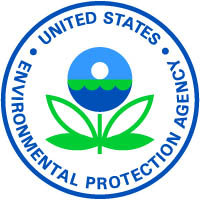 on new information received since 2011, including public comments. The assessment is, in part, in response to a petition submitted by Natural Resources Defense Council (NRDC) and Pesticide Action Network (PAN) in 2007, which called on the agency to ban all uses of the insecticide. In 2000, EPA orchestrated a voluntary cancellation with the manufacturer Dow AgroSciences of  most residential uses of chlorpyrifos to limit children’s exposure,  while most agricultural uses remain in use. Since then advocates across the country have called on EPA to ban the chemical, citing its potent toxicity. In 2010, over 13,000 organizations and individuals submitted a letter to EPA calling for a ban. In 2012, EPA imposed “no-spray” buffer zones around public spaces, including recreational areas, schools and homes to reduce bystander exposure risks. But in spite of these restrictions, chlorpyrifos still poses risks to human and environmental health because the agency refuses to step up and ban the chemical.
on new information received since 2011, including public comments. The assessment is, in part, in response to a petition submitted by Natural Resources Defense Council (NRDC) and Pesticide Action Network (PAN) in 2007, which called on the agency to ban all uses of the insecticide. In 2000, EPA orchestrated a voluntary cancellation with the manufacturer Dow AgroSciences of  most residential uses of chlorpyrifos to limit children’s exposure,  while most agricultural uses remain in use. Since then advocates across the country have called on EPA to ban the chemical, citing its potent toxicity. In 2010, over 13,000 organizations and individuals submitted a letter to EPA calling for a ban. In 2012, EPA imposed “no-spray” buffer zones around public spaces, including recreational areas, schools and homes to reduce bystander exposure risks. But in spite of these restrictions, chlorpyrifos still poses risks to human and environmental health because the agency refuses to step up and ban the chemical.
Children
In the 2011 assessment, EPA proposed to reduce the Food Quality Protection Act (FQPA) safety factor for certain exposures. This safety factor is an additional “margin of safety” put in place to protect vulnerable populations, especially children, from pesticide exposures. Beyond Pesticides and others in comments challenged EPA’s reduction of the  safety factor, given that the human health risk, especially to children, is associated with significant neurodevelopmental effects. In response to this, recent neurotoxicity data, and feedback from a 2012 Scientific Advisory Panel- that found chlorpyrifos exposures during certain developmental periods produced significant and long-term effects, EPA now states that it will retain the FQPA 10X safety factor for “infants, children, youths, and women of childbearing age for all exposure scenarios.”
Farmworkers
According to EPA, this latest assessment shows “some risks to workers who mix, load and apply chlorpyrifos pesticide products.” The agency states that “’additional restrictions may be necessary to ensure that workers who use or work around areas treated with chlorpyrifos are protected…” The agency notes that it will now begin discussions to put yet more restrictions in place to reduce these risks. However, anything short of a ban on chlorpyrifos will continue to place farmworkers at risk from chlorpyrifos, especially workers and their families living in the vicinity of treated fields. Dermal and oral exposures to aerial spraying and inhalation exposures to ground spraying result in elevated exposures. EPA’s 2013 volatilization assessment confirms that vapor phase chlorpyrifos may be emitted from treated fields at levels resulting in exposure to children and others who live, work, attend school, or otherwise spend time nearby. EPA reports that for some scenarios protective equipment can mitigate risks, but risks remain for over 126 exposure scenarios that cannot mitigated with protective equipment, which supports previous assertions that EPA’s assessments continue to show that chlorpyrifos uses cannot be adequately mitigated by protective equipment.
Drinking Water
Additionally, EPA finds that when used in large amounts, “chlorpyrifos has the potential to pose risks in limited geographic areas when drinking water from small watersheds.” EPA confirms previous findings that chlorpyrifos’ metabolite, chlorpyrifos oxon, can pose a threat to drinking water. Little environmental data exists for this metabolite, but it is more toxic than its parent and can persist through water treatment and remain in drinking water. The agency indicates that work will be carried out to “pinpoint community drinking water systems where exposure to chlorpyrifos oxon as a result of chlorpyrifos applications may pose an exposure concern.”
Chlorpyrifos is an organophosphate insecticide that is known to be neurotoxic. It is a cholinesterase inhibitor, which means that it can bind irreversibly to acetylcholine esterase (AchE), an essential enzyme for normal nerve impulse transmission in the brain, inactivating the enzyme. Studies have documented that exposure to even low levels of organophosphates like chlorpyrifos during pregnancy can impair learning, change brain function and alter thyroid levels of offspring into adulthood. The evidence of the neurotoxic dangers associated with chlorpyrifos’ exposure is extensive and consistent. One study from the University of California, Berkeley, which examined families in the intensive agricultural region of Salinas Valley, California, found that IQ levels for children with the most organophosphate exposure were a full seven IQ points lower than those with the lowest exposure levels. The Berkeley team also found that every tenfold increase in measures of organophosphates detected during a mother’s pregnancy corresponded to a 5.5 point drop in overall IQ scores in the 7-year-olds. Researchers from Mount Sinai School of Medicine also found that prenatal exposure to organophosphates is negatively associated with cognitive development, particularly perceptual reasoning, with evidence of effects beginning at 12 months and continuing through early childhood. Visit Pesticide Induced-Disease Database (PIDD).
Last September, the California Department of Pesticide Regulation announced steps for tighter oversight of applications of chlorpyrifos in the state. However, restrictions do not go far enough. PAN and NRDC, as a follow up to their 2007 petition, filed another suit asking the court to find that EPA has “unreasonably delayed fulfilling its legal obligations” and that the agency respond to the 2007 petition by issuing a final decision by the end of 2014.
Once again, when it comes to chlorpyrifos, EPA prefers to simply mitigate risk. By focusing on risk reduction strategies to come up with “acceptable,” but unnecessary, rates of illness across the population, EPA continues to underestimate the impact of the chemical’s continued widespread use in agriculture. Chlorpyrifos is highly neurotoxic and a frequent water contaminant and long range contaminant, exposing communities and contaminating areas far from where it was applied. Residues in food and water continue to put public health at risk. Beyond Pesticides has long advocated for an enlightened policy approach to proposed or continued toxic chemical use, in an age where the adverse effects have been widely and increasingly documented, is to first ask whether there is a less toxic way of achieving the toxic chemical’s intended purpose. Simply, “Is there another practice that would make the substance unnecessary?” This approach does not preclude and should demand the prohibition of high hazard chemical use, those chemicals that are simply too dangerous.
Hazards associated with toxic pesticides, such as chlorpyrifos, are unnecessary, and therefore unacceptable, given the viability of organic agricultural practices that integral to a growing $35 billion  market. See Beyond Pesticides’  organic program page.
This human health assessment will be open for a 60 day comment period once published in the Federal Register.
All unattributed positions and opinions in this piece are those of Beyond Pesticides.
Source: EPA News Release
Posted in Agriculture, Chemicals, Chlorpyrifos, Developmental Disorders, Farmworkers, Lawns/Landscapes, organophosphate, Take Action, Water by: Beyond Pesticides
No Comments
06
Jan
(Beyond Pesticides, January 6, 2015) At the close of 2014, the U.S. Fish and Wildlife Service (FWS) announced plans to conduct a year-long status review of the monarch butterfly to determine whether the species is eligible for protection under the Endangered Species Act (ESA). FWS is taking this action as result of an August 2014 legal petition filed by health and environmental groups that presented substantial information indicating that listing under the ESA may be warranted. In November 2014, Beyond Pesticides joined over 200 environmental groups and businesses in a letter asking for federal protection for monarch butterflies in the wake of shocking declines.
 The North American monarch butterfly population fell by 90 percent in the past 20 years, dropping from a high of approximately  one billion in the mid-1990s to fewer than 35 million butterflies in the winter of 2013-2014— the lowest number ever recorded. Each year monarch butterflies travel over 2,000 miles between Canada, the U.S., and Mexico, across multiple generations, to reach their winter hibernation grounds in late October. As FWS indicates, this journey has become “more perilous for many monarchs” due to threats along their migratory paths. Scientists believe the butterfly’s decline is being driven in large part by the loss of milkweed plants in the Midwest where most monarchs are born. FWS also mentions the direct threat of moralities from pesticide exposure.
The North American monarch butterfly population fell by 90 percent in the past 20 years, dropping from a high of approximately  one billion in the mid-1990s to fewer than 35 million butterflies in the winter of 2013-2014— the lowest number ever recorded. Each year monarch butterflies travel over 2,000 miles between Canada, the U.S., and Mexico, across multiple generations, to reach their winter hibernation grounds in late October. As FWS indicates, this journey has become “more perilous for many monarchs” due to threats along their migratory paths. Scientists believe the butterfly’s decline is being driven in large part by the loss of milkweed plants in the Midwest where most monarchs are born. FWS also mentions the direct threat of moralities from pesticide exposure.
Milkweed plants are the only food source monarch larvae are able to eat, making them critical for the butterfly’s long-term survival. According to a study published in the Journal of Animal Ecology in 2014, one of the primary reasons for milkweed decline is the rise of genetically engineered (GE) crops tolerant of herbicides such as glyphosate (Roundup). The expansion of GE agriculture over the past two decades has resulted in significant increases in herbicide use. In practice, these chemicals act non-selectively on weeds, resulting in widespread elimination of habitat that includes milkweed and other plants beneficial to pollinator populations. GE crops are often coated in toxic neonicotinoids, an insecticide that has been implicated in the global decline of honey bees.
FWS’ consideration of federal protection for monarchs is a positive step towards improving habitat and raising awareness about the decline of the butterfly, as well as the plight of other pollinator populations. In late October 2014, the U.S. Department of Agriculture (USDA) provided an additional $4 million on top of $3 million pilot investment announced earlier last year to help farmers and ranchers provide habitat for pollinators. At the same time, the Council on Environmental Quality announced new guidelines to help federal agencies incorporate pollinator friendly practices at federal facilities and on federal lands. These actions are a response to a Presidential Memorandum issued at the close of National Pollinator Week 2014, which directed federal agencies to establish a pollinator health task force and develop a pollinator health strategy. Despite a requirement that a strategy be developed within 180 days, a plan is not likely to be released until late this winter.
FWS has opened a 90 day public comment period for the ESA review, which is available at regulations.gov under docket number FWS-R3-ES-2014-0056. The ESA allows species to be listed as “threatened” when they are at risk of becoming endangered in a significant portion of their range. This would allow for the protection of the species but also still allow the continuation of activities that promote their conservation, such as scientific research and monitoring, citizen monitoring and tagging, and non-commercial classroom and household rearing of monarchs for educational purposes. In its press release FWS indicates that it is specifically interested in garnering public input on the following points:
- The subspecies’ biology, range and population trends, habitat requirements, genetics and taxonomy;
- Historical and current range, including distribution patterns;
- Historical and current population levels and current and projected trends;
- The life history or behavior of the monarch butterfly that has not yet been documented;
- Thermo-tolerance range and microclimate requirements of the monarch butterfly;
- Past and ongoing conservation measures for the subspecies, its habitat or both; Â and,
- Factors that are the basis for making a listing determination under section 4(a) of the ESA;
In addition to providing a public comment in support of listing the monarch under the ESA, residents can take action in their own backyards to support populations of monarchs, bees, and other pollinators. A necessary first step is to avoid using toxic pesticides in and around your home, and encourage others to do the same. Planting milkweed in your backyard is a surefire way to help monarch populations, and for other helpful tips, see Beyond Pesticides’ webpage on Managing Landscapes with Pollinators in Mind. Concerned residents can also read up on the numerous threats monarchs and other pollinators are experiencing in the article Bees, Birds, and Beneficial’s: How Fields of Poison Adversely Affect Non-target Organisms, and find more ways to take action in your community through the BEE Protective webpage.
All unattributed positions and opinions in this piece are those of Beyond Pesticides.
Sources: Fish and Wildlife Service Press Release, St. Louis Post-Dispatch
Posted in Agriculture, Announcements, Chemicals, Genetic Engineering, Lawns/Landscapes, Litigation, neonicotinoids, Pollinators, Take Action, Wildlife/Endangered Sp. by: Beyond Pesticides
No Comments
05
Jan
(Beyond Pesticides, January 5, 2015) Hawai’i County plans to appeal a federal judge’s ruling invalidating a 2013 county law restricting genetically engineered (GE) crops on the island. The County Council voted 5-4 in December to appeal the ruling after the judge ruled last November that Hawai’i County cannot enforce a law restricting genetically engineered crops because it is preempted by state law. The ruling follows a similar federal court decision in August 2014 that overrules a Kauai ordinance requiring annual reporting of genetically engineered organisms.
 U.S. Magistrate Judge Barry Kurren’s order is similar to his earlier decision invalidating Kauai County’s law on pesticides and GE crops. Judge Kurren invalidated the county law, Hawai`i County Ordinance 13-121, in a Nov. 27, 2014 order, saying state law preempts county law on the issue. He said lawmakers intended the state to have broad oversight of agricultural issues in Hawai’i. The November 2014 decision concludes that state “preemption” of the county ordinance is implied by state plant laws, despite the fact none of them mention GE crops or were intended to regulate them. The court refused a request to send the state law question to the Hawai’i Supreme Court  for a  decision. Finally, the court rejected the chemical companies’ argument that county and state regulation of commercialized GE crops is prohibited by federal law, but concludes that  federal law does prohibit regulation of some, but not all, experimental plantings.
U.S. Magistrate Judge Barry Kurren’s order is similar to his earlier decision invalidating Kauai County’s law on pesticides and GE crops. Judge Kurren invalidated the county law, Hawai`i County Ordinance 13-121, in a Nov. 27, 2014 order, saying state law preempts county law on the issue. He said lawmakers intended the state to have broad oversight of agricultural issues in Hawai’i. The November 2014 decision concludes that state “preemption” of the county ordinance is implied by state plant laws, despite the fact none of them mention GE crops or were intended to regulate them. The court refused a request to send the state law question to the Hawai’i Supreme Court  for a  decision. Finally, the court rejected the chemical companies’ argument that county and state regulation of commercialized GE crops is prohibited by federal law, but concludes that  federal law does prohibit regulation of some, but not all, experimental plantings.
A month later, the County Council voted 5-4 to appeal the November 2014 ruling, citing concerns for local farmers and a reluctance to enter what could be lengthy litigation. Kohala Councilwoman Margaret Wille, who authored the original bill limiting GE organisms, said it is an important decision affecting home rule.
Citing public health and environmental concerns, Ordinance 13-121 (previously Bill 113) passed the County Council with large public support. The ordinance, passed by the County Council 6-3 in November 2013, bans growing GE crops in open-air conditions, and makes exceptions for papaya and corn already growing on the island, as well as scientific study in greenhouses and other enclosed settings. The ordinance banned the growing of new GE crops on the island. It also included a $1,000 per day fine for violations. A lawsuit was filed in June 2014 by several Big Island farmers and flower growers, along with a national trade organization representing the biotech industry, challenging the ordinance.
Kauai is also appealing a similar ruling made by Judge Kurren invalidating a Kauai County law regulating GE crops and pesticide use, while residents of Maui County passed a ballot initiative to halt GE crop production until public safety tests are conducted. That initiative is also being challenged by the biotech industry in court.
Additional background on the fight for increased protections on the Hawaiian Islands, including testimony Beyond Pesticides provided in support of Kauai’s Bill 2491, can be found here. For more information on the hazards that continue to be associated with the growth of GE agriculture, see Beyond Pesticides Genetic Engineering webpage.
All unattributed positions and opinions in this piece are those of Beyond Pesticides.
Source: Honolulu Star
Posted in Agriculture, Announcements, Contamination, Genetic Engineering, Hawaii, Litigation, National Politics, Pesticide Drift, Pesticide Regulation, Pesticide Residues, State/Local by: Beyond Pesticides
No Comments
24
Dec
The staff and Board of Beyond Pesticides extend our sincere gratitude and wish for a happy and healthy holiday season and New Year to all those who have joined with us in taking  or supporting action  to promote health and environmentally responsible practices in 2014. Our Daily News is taking a holiday break and will return on Monday, January 5, 2015 with renewed energy and vision to continue fighting for broader adoption of organic  practices for a sustainable future.
 Whatever your current level of involvement with Beyond Pesticides: whether you work with us directly to make changes in your community, have received help through an information request, participate in our online actions, like or follow us on social media, or simply read and share our website and Daily News with friends and family, your contributions are a critical part of the pesticide-free grassroots movement that continues to strengthen and grow. We hope you will continue to lend your support in 2015.
Whatever your current level of involvement with Beyond Pesticides: whether you work with us directly to make changes in your community, have received help through an information request, participate in our online actions, like or follow us on social media, or simply read and share our website and Daily News with friends and family, your contributions are a critical part of the pesticide-free grassroots movement that continues to strengthen and grow. We hope you will continue to lend your support in 2015.
In order to help us realize the critical protections we’re all fighting for, please consider becoming a member, providing a year-end tax-deductible donation, or purchasing a pesticide-free zone sign from our online store. With your help, we advance scientific understanding  that informs the need for improved chemical restrictions  —challenging unprotective regulatory decisions and effecting changes in policies and practices that protect health and the environment,  from local communities  to the federal government.
As we count the victories this year, we must also consider the challenges that still lie ahead. Beyond Pesticides believes that by working with you, in partnership  with people and organizations nationwide, we will realize critical achievements in the  coming year:
 BEE Protective Victories: From Vermont Law School to Seattle, Washington; the dedicated activists at Bee Safe Boulder, all the way up to U.S. National Wildlife Refuges, 2014 has seen institutions of all sizes take BEE Protective action and restrict the use of toxic neonicotinoids and protect pollinator populations. These actions are part of a larger shift in pest management towards organic alternatives that focus on physical, cultural, mechanical, and biological controls before considering synthetic pesticides.
BEE Protective Victories: From Vermont Law School to Seattle, Washington; the dedicated activists at Bee Safe Boulder, all the way up to U.S. National Wildlife Refuges, 2014 has seen institutions of all sizes take BEE Protective action and restrict the use of toxic neonicotinoids and protect pollinator populations. These actions are part of a larger shift in pest management towards organic alternatives that focus on physical, cultural, mechanical, and biological controls before considering synthetic pesticides.
What lies ahead: Victories in communities and select institutions are critical to moving forward on broader restrictions at the federal level. At the close of Pollinator Week 2014, President Obama created a Pollinator Task Force to promote the health of bees and other wild pollinators. Groups and concerned residents across the country called on the President to #BeeKindObama and make sure that the Task 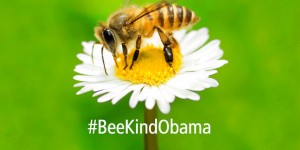 Force takes meaningful action and suspends these toxic chemicals. We need your help to continue to put pressure on the POTUS: become active in your community and advocate for BEE Protective policies; share your story on the importance of pollinators in your life; and continue to educate others on this critical issue. One in three bites of food depends on pollinators, so resolve to save them in 2015!
Force takes meaningful action and suspends these toxic chemicals. We need your help to continue to put pressure on the POTUS: become active in your community and advocate for BEE Protective policies; share your story on the importance of pollinators in your life; and continue to educate others on this critical issue. One in three bites of food depends on pollinators, so resolve to save them in 2015!
Saving Our Organic: This year the National Organic Standards Board voted to remove the last antibiotic allowed in organic production. A landmark study found clear health benefits from eating organic food over conventional, and another showed dramatically lower pesticide exposure after switching to an organic diet. It’s no surprise that poll after poll this year found consumers actively seeking out organic options for health and environmental reasons. This is why Beyond Pesticides finds it so critical to maintain and uphold the standards and values put forward by the Organic Foods Production Act, bringing an important and forceful voice to efforts that must ensure organic integrity.
 What lies ahead: As organic experiences “growing pains” associated with certification, pictures of factory farms in violation of the law dishearten consumers, and shake the public’s trust in the organic label. To add insult to injury, the National Organic Program’s recent changes to the authority of the National Organic Standards Board and procedures for sunset review must continue to be vigorously challenged in order to defend organic, and keep it from sliding into conventional practices. Please continue to stay up to date with Beyond Pesticides’ Keep Organic Strong page, and take action on the Save Our Organic website.
What lies ahead: As organic experiences “growing pains” associated with certification, pictures of factory farms in violation of the law dishearten consumers, and shake the public’s trust in the organic label. To add insult to injury, the National Organic Program’s recent changes to the authority of the National Organic Standards Board and procedures for sunset review must continue to be vigorously challenged in order to defend organic, and keep it from sliding into conventional practices. Please continue to stay up to date with Beyond Pesticides’ Keep Organic Strong page, and take action on the Save Our Organic website.
Rejecting the Genetically Engineered (GE) Pesticide Treadmill: This year the Environmental Protection Agency denied Texas cotton growers an emergency exemption to use the hazardous herbicide triazine to control resistant weeds, citing concerns for drinking water. Communities in Hawaii remain stalwart in their fight for protections from incessant pesticide applications near where they live, work, and play. And, the grassroots movement on the islands continues to make history. Maui County was able to achieve an amazing upset over agrichemical giants, temporarily banning the planting of GE crops in a popular vote, despite being outspent by 87 to 1. Maui joined Jackson and Josephine Counties in Oregon, which banned the planting of all GE crops outright. Vermont became the first state in the country to require labeling on GE foods, and has moved forward despite a lawsuit from Monsanto and the Grocery Manufacturers Association.
 What lies ahead: Contrary to firm and increasing evidence showing the failure of the GE model, regulators are doubling down on their mistakes, allowing a new, more toxic herbicide to be sprayed on novel pesticide-tolerant crops. Notwithstanding the victory in Vermont, proponents of labeling GE foods encountered a roadblock in Colorado and in Oregon, where a ballot measure was defeated by one of the slimmest margins in state history despite huge spending by chemical companies. Numerous instances of GE contamination also reared its head in 2014, as China rejected shipments of Syngenta corn, and Montana discovered another incident of unauthorized release of GE wheat. GE agriculture undermines the organic model, which, as a recent UC Berekley study found, can and must be the system to feed the world. According to a 2014 survey, one third of U.S. organic farmers have experienced GE contamination. Individuals wishing to reject the GE model can purchase organic foods, and advocate for labeling and restrictions on GE plantings within their community.
What lies ahead: Contrary to firm and increasing evidence showing the failure of the GE model, regulators are doubling down on their mistakes, allowing a new, more toxic herbicide to be sprayed on novel pesticide-tolerant crops. Notwithstanding the victory in Vermont, proponents of labeling GE foods encountered a roadblock in Colorado and in Oregon, where a ballot measure was defeated by one of the slimmest margins in state history despite huge spending by chemical companies. Numerous instances of GE contamination also reared its head in 2014, as China rejected shipments of Syngenta corn, and Montana discovered another incident of unauthorized release of GE wheat. GE agriculture undermines the organic model, which, as a recent UC Berekley study found, can and must be the system to feed the world. According to a 2014 survey, one third of U.S. organic farmers have experienced GE contamination. Individuals wishing to reject the GE model can purchase organic foods, and advocate for labeling and restrictions on GE plantings within their community.
 Expanding the Takoma Park Model: The passage of Ogunquit, Maine’s pesticide-free ordinance (twice!) this year shows the desire within local communities not subject to state preemption to restrict pesticides in a way that protects the health of residents and the environment. By prohibiting pesticide use on public and private property for lawn and landscape purposes, Ogunquit is paving the way for other localities in the state. The small town of Skagway, Alaska also took advantage of the lack of preemption in the state by banning bee-harming neonicotinoids and persistent herbicides, and placing strong restrictions on the use of lawn care pesticides. Now, Montgomery County, MD has picked up on the momentum that activists in Takoma Park, MD brought through the successful passage of the Safe Grow Act. In October, the Montgomery County Council introduced Bill 52-14 based upon growing concerns in the community of the health risks associated with exposure to pesticides.
Expanding the Takoma Park Model: The passage of Ogunquit, Maine’s pesticide-free ordinance (twice!) this year shows the desire within local communities not subject to state preemption to restrict pesticides in a way that protects the health of residents and the environment. By prohibiting pesticide use on public and private property for lawn and landscape purposes, Ogunquit is paving the way for other localities in the state. The small town of Skagway, Alaska also took advantage of the lack of preemption in the state by banning bee-harming neonicotinoids and persistent herbicides, and placing strong restrictions on the use of lawn care pesticides. Now, Montgomery County, MD has picked up on the momentum that activists in Takoma Park, MD brought through the successful passage of the Safe Grow Act. In October, the Montgomery County Council introduced Bill 52-14 based upon growing concerns in the community of the health risks associated with exposure to pesticides.
 What lies ahead: Activists must remain vigilant by defending and successfully implementing current laws while continuing to push for increased protections. The town of Chilmark, MA’s attempts to stop the spraying of a sensitive lake with glyphosate shows the need to continue fighting regressive preemption laws. Buoyed by efforts in other states, individuals can take action by participating in their local democratic institutions. Start your own local movement, and fight for protections from unnecessary pesticide spraying in your community. Even if your state is preempted, you can still work to enact a policy that stops pesticide spraying on public land, which builds momentum for larger efforts. And, ask your elected representatives in the state legislature  to repeal state law  that currently preempts local authority to restrict pesticides in the state’s towns and cities.
What lies ahead: Activists must remain vigilant by defending and successfully implementing current laws while continuing to push for increased protections. The town of Chilmark, MA’s attempts to stop the spraying of a sensitive lake with glyphosate shows the need to continue fighting regressive preemption laws. Buoyed by efforts in other states, individuals can take action by participating in their local democratic institutions. Start your own local movement, and fight for protections from unnecessary pesticide spraying in your community. Even if your state is preempted, you can still work to enact a policy that stops pesticide spraying on public land, which builds momentum for larger efforts. And, ask your elected representatives in the state legislature  to repeal state law  that currently preempts local authority to restrict pesticides in the state’s towns and cities.
 On April 17-18, 2015, the 33rd National Pesticide Forum will take place in Orlando, Florida at Florida A&M University College of Law. Florida is a hotbed of activity regarding pesticide use on turf and for mosquito control, organic agriculture, wildlife conservation and farmworker rights. We hope to see you there to help organize and continue building the pesticide-free movement. Check out Beyond Pesticides’ YouTube channel on our 2014 Forum in Portland, Oregon.
On April 17-18, 2015, the 33rd National Pesticide Forum will take place in Orlando, Florida at Florida A&M University College of Law. Florida is a hotbed of activity regarding pesticide use on turf and for mosquito control, organic agriculture, wildlife conservation and farmworker rights. We hope to see you there to help organize and continue building the pesticide-free movement. Check out Beyond Pesticides’ YouTube channel on our 2014 Forum in Portland, Oregon.
Thank you all again for working with us in 2014. We’re so excited to see what your support will help us achieve in the New Year. All best wishes for the new year.
All unattributed positions and opinions in this piece are those of Beyond Pesticides.
Posted in Announcements, Holidays, Take Action by: Beyond Pesticides
No Comments
23
Dec
(Beyond Pesticides, December 23, 2014) The U.S. Department of Agriculture’s (USDA) Agricultural Marketing Service (AMS) has posted a report on its data from the 2013 Pesticide Data Program (PDP) Annual Summary, concluding that although over half of the food tested by the agency for pesticide residues last year showed detectable levels of pesticides, these levels are below the tolerances established by the Environmental Protection Agency (EPA) and do not pose a safety concern. The residues reflect a pesticide use and exposure pattern that raises hazard scenarios that are not fully evaluated by EPA for chemical mixtures, synergistic effects, impacts  on  people and environments  with high risk factors, and certain critical health endpoints, such as endocrine disruption  .
 Excluding water, of the 9,990 samples analyzed, 23.5 percent had one pesticide detected and 36 percent had more than one pesticide. Residues exceeding tolerances were detected in 0.23 percent (23 samples out of 9,990) of the samples tested. Of these 23 samples, 17 were imported and 6 were domestic. Residues with no established tolerances were found in 3.0 percent of samples, of which 50.2 percent were domestic and 49.2 percent imported.
Excluding water, of the 9,990 samples analyzed, 23.5 percent had one pesticide detected and 36 percent had more than one pesticide. Residues exceeding tolerances were detected in 0.23 percent (23 samples out of 9,990) of the samples tested. Of these 23 samples, 17 were imported and 6 were domestic. Residues with no established tolerances were found in 3.0 percent of samples, of which 50.2 percent were domestic and 49.2 percent imported.
According to USDA, “The Pesticide Data Program provides reliable data through rigorous sampling that helps assure consumers that the produce they feed their families is safe. Over 99 percent of the products sampled through PDP had residues below the EPA tolerances.”
The assertion that pesticides in the U.S. food supply do not pose safety concerns rests on shaky ground, according to a recent report from the Governmental Accountability Office (GAO) titled Food Safety: FDA and USDA Should Strengthen Pesticide Residue Monitoring Programs and Further Disclose Monitoring Limitations. One of GAO’s findings documents  flaws in AMS’s sampling methodology, stating that it does not meet many of the Office of Management and Budget’s (OMB) best practices for conducting and releasing information to the public on a data collection effort, such as those that are important to ensure that the data the agency collects are nationally representative. The report continues, “As AMS does not disclose these limitations in its annual monitoring reports, users of the data may misinterpret information in these reports and draw erroneous conclusions based on the data.” The GAO report also criticizes the U.S. Food and Drug Administration (FDA), which collects and analyzes pesticide residue data in order to enforce EPA tolerances, for not using statistically valid methods consistent with OMB standards. GAO states that it “was unable to find publicly available estimates of the overall toxicity or risk associated with the use of agricultural pesticides in the United States.” According to GAO, FDA is testing less than one-tenth of one  percent of all imported fruits and vegetables and less than one percent of domestic fruits and vegetables.
Additionally, both FDA and USDA fail to test for glyphosate, the active ingredient in Roundup, one of the most widely used herbicides in the world. According to a USDA spokesman, test measures required for glyphosate are “extremely expensive…to do on a regular basis.” However, lack of testing, coupled with Monsanto’s request and subsequent EPA approval for increased tolerance levels for glyphosate, means bad news for our food, health, and the environment.
Pesticide use in conventional agriculture does not just affect consumers. Beyond the impacts that residues of pesticides have  on  people who eat food grown with chemical-intensive practices, the pesticides used in conventional food production can also have devastating impacts where they are used,  poison farmworkers, and cause  cancer,  Parkinson’s, and other chronic diseases in rural communities.  Children of farmworkers  are also at elevated risk.
For more information on the health effects of pesticide exposure, see Beyond Pesticides’ Pesticide-Induced Diseases Database. To learn more about pesticides and the foods you eat, see Beyond Pesticides’  Eating with a Conscience. For more information on organic food production, see Beyond Pesticides’  Organic Agriculture webpage.
Source: Fox News, USDA
All unattributed positions and opinions in this piece are those of Beyond Pesticides.
Posted in Agriculture, Alternatives/Organics, Announcements, Cancer, Chemicals, Disease/Health Effects, Endocrine Disruption, Farmworkers, glufosinate, Label Claims, Parkinson's, Pesticide Residues, Take Action by: Beyond Pesticides
1 Comment
22
Dec
(Beyond Pesticides, December 22, 2014) Stunning aerial photographs of certified  organic farms taken in an investigation launched by The Cornucopia Institute reveal industrial-scale operations housing thousands of animals in cramped conditions with no access to the outdoors. Access to pasture for ruminants like dairy cows is required under National Organic Program (NOP) regulations, and all livestock certified organic must have a means of reaching the outdoors year-round. “The vast majority of these massive, industrial-scale facilities, some managing 10,000-20,000 head of cattle, and upwards of 1 million laying hens, had 100% of their animals confined in giant buildings or feedlots,” said Mark Kastel, Senior Farm Policy Analyst at the Wisconsin-based Cornucopia Institute, which has filed a legal complaint against 14 livestock operations it alleges are illegally marketing themselves as organic.
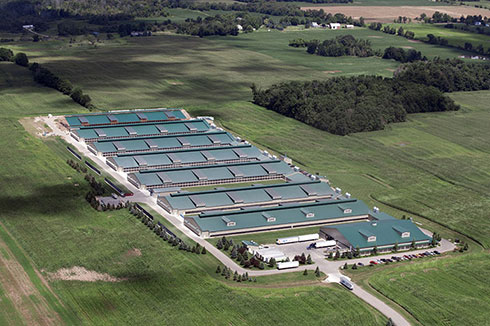 It is important to note that not all organic farms house their animals in conditions seen in the aerial photographs. “Many of our dairy farmer-members have animals, they truly care for, that have names, not numbers,” Kastel explained. However, environmental and consumer groups have been sounding an alarm over the increased dependency many larger industry-owned farms have developed  on synthetic inputs temporarily allowed in organic production. These practices undermine the values and the integrity that consumers come to expect from the organic label.
It is important to note that not all organic farms house their animals in conditions seen in the aerial photographs. “Many of our dairy farmer-members have animals, they truly care for, that have names, not numbers,” Kastel explained. However, environmental and consumer groups have been sounding an alarm over the increased dependency many larger industry-owned farms have developed  on synthetic inputs temporarily allowed in organic production. These practices undermine the values and the integrity that consumers come to expect from the organic label.
One such synthetic chemical is methionine, an essential amino acid that living beings can only receive through food, but is produced in chemical plants with inputs such as methyl mercaptan, which recently poisoned four DuPont workers. Many large-scale organic poultry producers have come to rely on the input rather than provide adequate access to pasture that allows poultry to receive this nutrient through insects and worms. In 2002, the NOP permitted a “porched-poultry” loophole that essentially allows a small porch to be considered access to the outdoors. “Quite frankly, even if Miles McEvoy, who currently directs the NOP, believes that a porch, with a floor, ceiling and screened walls, constitutes ”˜the outdoors,’ if only 5% of the birds have access or can fit in that space, then 95% of the others are being illegally confined,” Cornucopia’s Kastel stated. In 2011, the National Organic Standards Board submitted a formal recommendation to NOP which included the requirement that poultry operations “establish and maintain poultry living conditions that accommodate health and natural behavior,” and set minimum space for birds, and standards regarding outdoor access areas. Despite a unanimous vote by the NOSB, NOP has yet to act and adopt formal rules carrying out the Board’s request.
Moreover, recent changes to NOP rules reflect the growing influence of large corporations that have bought-up and consolidated small organic companies. Late last year, NOP head Miles McEvoy disallowed the NOSB from setting its own work plan and agenda, and mistakenly re-categorized the Board as time-limited, despite its permanent independent authority established by the Organic Foods Production Act. Although, in response to a petition by Beyond Pesticides, Center for Food Safety, and other organic farm and consumer groups, the NOP agreed to change the charter to reflect the permanence of the Board, it continued to limit the Board’s ability to define its own agenda.
NOP also changed procedures for “sunsetting” synthetics allowed in organic production, which are determined by NOSB. Previously, a two-thirds majority of the NOSB was required to continue the allowance synthetic material after a five year period. Now, NOP rules require a two-thirds majority to remove a synthetic substance. If this rule had been changed earlier, NOSB would not have had to votes to, for instance, remove the uses of antibiotics in apple and pear production, a change hailed by many farmers, consumers, and environment and health advocates. NOP made these changes without any prior notice, consultation, or public comment period.
“The current situation, applauded by the industry’s most financially powerful interests, and almost universally condemned by nonprofits representing farmers and consumers, is untenable,” said Jay Feldman, Executive Director of Beyond Pesticides and a current Obama administration appointee to the 15-member NOSB. “Someone needs to take responsibility for the divide in this industry which has begun seriously undercutting the credibility of the organic label and the livelihoods of ethical organic farmers.”
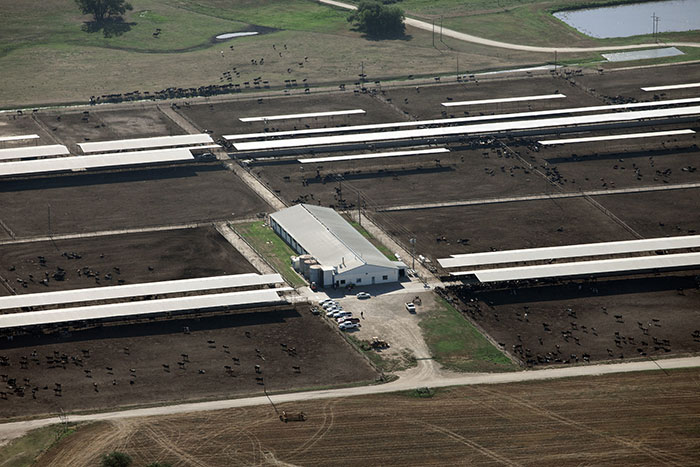 As the aerial photographs taken by Cornucopia show (view them all here), there is a significant risk with changes that raise the bar to remove unnecessary synthetics. Rather than creating a systems approach, these changes create a dangerous dependency on unethical practices that compromise the quality of organic food, the environment, and local communities surrounding these factory farms, as well as consumers’ expectation of the organic food label. While Aurora Organic Dairy, one of the dairy farms pictured, told the Washington Post  that ”A single photo doesn’t really tell us anything about a farm and its practices,” a picture speaks a thousand words, and consumers are certainly reading the message. As organic continues to grow, it is critical that factory farms and confined animal feeding operations (CAFOs) not become the norm, as this risks a slide toward conventional practices and damages the high bar that many responsible organic producers work day and night to achieve for their customers.
As the aerial photographs taken by Cornucopia show (view them all here), there is a significant risk with changes that raise the bar to remove unnecessary synthetics. Rather than creating a systems approach, these changes create a dangerous dependency on unethical practices that compromise the quality of organic food, the environment, and local communities surrounding these factory farms, as well as consumers’ expectation of the organic food label. While Aurora Organic Dairy, one of the dairy farms pictured, told the Washington Post  that ”A single photo doesn’t really tell us anything about a farm and its practices,” a picture speaks a thousand words, and consumers are certainly reading the message. As organic continues to grow, it is critical that factory farms and confined animal feeding operations (CAFOs) not become the norm, as this risks a slide toward conventional practices and damages the high bar that many responsible organic producers work day and night to achieve for their customers.
Organic agriculture, from the outset, is the only system of food production  that is subject to independent public review and oversight, working to assure consumers that toxic, hazardous synthetic pesticides used in conventional agriculture are replaced by management practices focused on soil biology, biodiversity, and plant health. This eliminates commonly used toxic chemicals in the production and processing of food that is not labeled organic —pesticides that contaminate our water and air, hurt biodiversity, harm farm workers, and kill bees, birds, fish and other wildlife.
Consumers and responsible organic farmers must stand up for organic integrity and take action to fight changes instituted by the National Organic Program. To aid this effort, Beyond Pesticides has created the Save Our Organic campaign, aimed at protecting the independent authority of the NOSB and re-instilling public trust in the label. Concerned organic consumers can also stay up to date on the latest actions of  the National Organic Standards Board (NOSB) by following Beyond Pesticides’  Keeping Organic Strong page, which tracks  issues before the Board and open to public comment.
Source and Photo Sources : The Cornucopia Institute
Posted in Agriculture, Alternatives/Organics, Chemicals, Farmworkers, Litigation, methionine, National Organic Standards Board/National Organic Program, National Politics, Pollinators, State/Local, Take Action by: Beyond Pesticides
No Comments
19
Dec
(Beyond Pesticides, December 19, 2014) Citing concerns over health risks, Governor Andrew M. Cuomo and his administration announced Wednesday that it would ban hydraulic fracturing, also known as “fracking,” in New York state, thus becoming the first state with significant natural-gas resources to ban the practice. Fracking is a method of extracting natural gas from deep in the ground by injecting a mixture of water, sand, and toxic chemicals ””including biocides to control biological activity”” under high pressure into dense rock formations, such as shale, in order to crack the rock and release the gas.
 The announcement to ban fracking came alongside a long-awaited health study. The study, made public during a year-end cabinet meeting convened by the governor in Albany, found “significant public health risks” associated with fracking.
The announcement to ban fracking came alongside a long-awaited health study. The study, made public during a year-end cabinet meeting convened by the governor in Albany, found “significant public health risks” associated with fracking.
The study also considers the effects of biocide use in the fracking process, such as reduced microbial diversity and enhanced tolerance from chemicals like glutaraldehyde, a strong irritant.
Hydraulic fracking operations use biocides because microbes, which are present beneath the surface of the earth, can interfere with the flow of gas in the pipelines. Sandra Steingraber, Ph.D., an ecologist and author, explained the possible role of these microbes and the use of biocides to the participants of the 30th National Pesticide Forum,  and in the  Huffington Post: “Living organisms also interfere with the flow of gas through pipelines. To prevent this biofouling, gas companies send powerful biocides into the shale, killing everything that inhabits it. The use of biocides, among other factors, makes fracking a highly toxic form of energy extraction.” Theo Colburn, Ph.D., founder of The Endocrine Disruption Exchange (TEDX), has also called attention to the health effects of chemicals used in the drilling, fracturing, recovery and delivery of natural gas.
Biocides, as well as hundreds of others products, used in the production of natural gas are often hidden from public scrutiny, making it difficult to thoroughly examine the full extent of potential public health and environmental impacts.
Major findings from the health study include air pollution from uncontrolled methane leakage, emissions of other volatile organic chemicals, and particulate matter; water-quality impacts from underground migration of methane, which has the potential to impact private drinking water wells, as well as from surface spills and radioactive waste disposal; seismic activity; and community impacts from interference with quality-of-life and overburdened transportation and health infrastructure. Health effects include association between birth outcomes (low birth weight and some congenital defects) and residential proximity of the mother to well pads during pregnancy, as well as congenital heart and neural tube defects, skin rash, irritation, nausea or vomiting, abdominal pain, breathing difficulties or cough, nosebleeds, and more in people and farm animals near fracking sites.
Howard A. Zucker, M.D., the acting New York State health commissioner, said there was insufficient scientific evidence to affirm the safety of fracking. He said his review boiled down to a simple question: Would he want his family living in a community where fracking was taking place?
He didn’t mince words; his answer was no.
“We cannot afford to make a mistake,” he said. “The potential risks are too great. In fact, they are not even fully known.”
Preceding the state ban, dozens of communities throughout the state have passed moratoriums and bans on fracking. In June, the Court of Appeals, the state’s highest court, ruled that towns could use zoning ordinances to ban fracking. Local bans, on top of state-planned restrictions, put 63 percent of the Marcellus Shale off limits to drilling, according to Joseph Martens, the state environmental conservation commissioner.
“The economic benefits are clearly far lower than originally forecast,” he said.
New York is not the first state to ban fracking. Vermont banned the practice in 2012, but the move was more symbolic in nature since the state does not actually possess a commercially viable source of natural gas. On a more local level, communities have taken the initiative across the country, banning fracking in cities throughout California, Colorado, Ohio, Pennsylvania, and Texas.
Source: New York Times
Photo Source: nyagainstfracking.org
All unattributed positions and opinions in this piece are those of Beyond Pesticides.
Posted in Chemicals, Fracking, Litigation, National Politics, New York, State/Local, Take Action by: Beyond Pesticides
1 Comment
18
Dec
(Beyond Pesticides, December 18, 2014) Beyond Pesticides joined Center for Food Safety (CFS) in filing a lawsuit late Tuesday against the U.S. Environmental Protection Agency (EPA) over the agency’s failure to regulate novel nanomaterial pesticides. In 2008 more than 13 organizations  filed a legal petition demanding the agency take action on this nanomaterial issues. Tuesday’s lawsuit challenges the agency for its failure to answer their petition while the proliferation of nanomaterials in consumer products continues unabated.
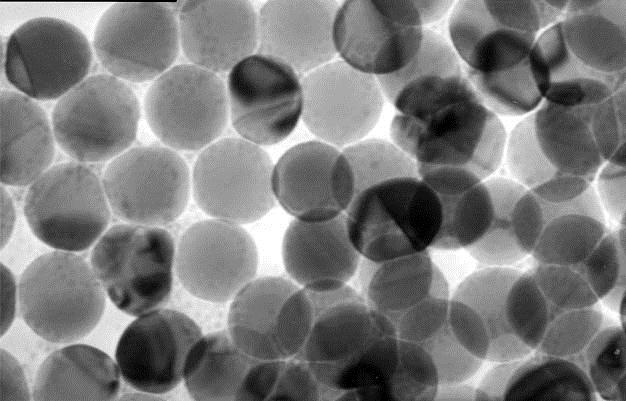 “It is unfortunate that it takes a lawsuit to get EPA to carry out its responsibility to regulate nano-silver for its toxic pesticidal properties and broad exposure patterns through consumer and personal care products,” said Jay Feldman, executive director of Beyond Pesticides. “Like any toxic pesticide, nano-silver must be subject to the full force of the law and label restrictions intended to protect people’s health and the environment,” Mr. Feldman said.
“It is unfortunate that it takes a lawsuit to get EPA to carry out its responsibility to regulate nano-silver for its toxic pesticidal properties and broad exposure patterns through consumer and personal care products,” said Jay Feldman, executive director of Beyond Pesticides. “Like any toxic pesticide, nano-silver must be subject to the full force of the law and label restrictions intended to protect people’s health and the environment,” Mr. Feldman said.
Nanotechnology is a platform technology for manipulating materials at the atomic and molecular level; manufactured nanomaterials are so small that they cannot be seen with an ordinary microscope. For comparison, a strand of human hair is 50,000 to 80,000 nanometers wide. Yet “nano” means more than just tiny; it means materials that have the capacity to act in fundamentally novel ways, ways that cannot be predicted from the same materials at larger scale. Their exponentially small size gives them extraordinary mobility for a manufactured material, as well as unique chemical and biological properties. Nanomaterials’ properties increase potential for biological interaction and increase potential for toxicity, which can result in DNA mutation, structural damage within the cell, and even cell death. Once in the blood stream, they can move freely through organs and tissues, including the brain, heart, liver, kidneys, spleen, bone marrow, and nervous system.
“Six years ago we provided EPA a legal and scientific blue print to address to regulate these novel materials under its pesticide authority. The agency’s unlawful and irresponsible delay ends now,” said CFS senior attorney George Kimbrell.
Products Containing Nanomaterials Should Be Registered As Pesticides
Nano-silver products are overwhelmingly the most common nanomaterial in consumer products, commonly used as a powerful antimicrobial agent. Because of nano-silver’s properties, it is considered a pesticide and active ingredient under the Federal Insecticide, Fungicide, and Rodenticide Act (FIFRA), the primary federal law governing pesticide use in the United States. Under FIFRA, any product containing an active ingredient that acts as a pesticide must be registered with EPA. For public health claims associated with pesticide use, EPA requires manufacturers to show that the product performs as intended and does not pose “unreasonable” adverse effects to the environment. “Unreasonable adverse effects on the environment,” is defined as one of two ways: (1) any unreasonable risk to man or the environment, taking into account the economic, social, and environmental costs and benefits of the use of any pesticide, or (2) a human dietary risk from residues that result from a use of a pesticide in or on any food inconsistent with the Federal Food Drug and Cosmetic Act (FFDCA). The manufacturer must also submit a proposed label for the product that meets all of FIFRA’s labeling requirements.
In the 2008 petition, petitioners identified 260 nano-silver consumer products not registered under FIFRA, and currently that number has increased to over 400 nano-silver products on the market today. Because there are no labeling requirements for nano-scale products, many more likely exist. These products carry with them significant risks to people and the environment, including DNA damage to plants, increasing bacterial resistance to antimicrobials, and toxic and potentially lethal impacts on fish.
Not the First Time EPA Sued Over Nano-Silver Products
Disturbingly, EPA knows nano-silver is a pesticide and has even taken companies to court for failing to register its product containing nano-silver. Most of the EPA actions on the subject of nano-silver, however, have been spurred by litigation and court orders.
The time has come for EPA to set defined standards for registration of this dangerous material and regulate it as FIFRA intends. The plaintiffs in the present suit represented by CFS legal counsel in the lawsuit are CFS, its sister nonprofit, the International Center for Technology Assessment, as well as Beyond Pesticides, the Center for Environmental Health, Clean Production Action, and the Institute for Agriculture and Trade Policy.
All unattributed positions and opinions in this piece are those of Beyond Pesticides.
Source: The Center for Food Safety
Posted in Litigation, Nanotechnology, National Politics, Take Action by: Beyond Pesticides
3 Comments
17
Dec
(Beyond Pesticides, December 17, 2014)  Supporters of an Oregon ballot initiative requiring labels on genetically-engineered (GE) food acknowledged defeat last Thursday after an automatic recount failed to change the results of November’s vote and a judge denied their plea for a count of rejected ballots. Advocates expressed deep disappointment that a Monsanto led multi-million dollar opposition campaign narrowly defeated the Oregon ballot initiative even after an emergency lawsuit was filed to prevent the rejection of over 4,000 votes due to non-fraudulent discrepancies.
Measure 92 lost by a narrow margin in November elections, triggering a recount and making it the closest statewide election in Oregon history. Measure 92 would have required manufacturers, retailers, and suppliers to clearly label all genetically-engineered foods or ingredients in raw or packaged items. It was defeated by only 812 votes out of 1.5 million. The automatic recount is pursuant to Oregon voting law, but the new tally showed that the measure lost by just 0.056 percent. On December 8, 2 014, an emergency lawsuit was filed by the Yes on 92 Campaign in order to prevent over 4,000 votes from being thrown out by state officials due to non-fraudulent discrepancies in voter signatures. Â The judge agreed that leaving the ballots uncounted would cause irreparable harm to those voters and to the campaign, but ultimately ruled that Oregon law did not allow him to issue the order to stop count.
014, an emergency lawsuit was filed by the Yes on 92 Campaign in order to prevent over 4,000 votes from being thrown out by state officials due to non-fraudulent discrepancies in voter signatures. Â The judge agreed that leaving the ballots uncounted would cause irreparable harm to those voters and to the campaign, but ultimately ruled that Oregon law did not allow him to issue the order to stop count.
“We draw strength from the fact that we came so achingly close to winning this vote,” the Yes on 92 Campaign said in a news release. “We will continue working until Oregonians and all Americans … have the information they need to make informed choices about the food that they feed their families.”
This was the most expensive campaign in Oregon’s history, and the pro-labeling group Yes on 92 Campaign was outspent $21 million to $9 million by ”˜No on 92,’ which was a counter-campaign led by major agribusiness and biotechnology companies Monsanto and DuPont, as well as the trade group Grocery Manufacturers Association. According to the Center for Food Safety (CFS), Monsanto donated nearly $5 million, DuPont Pioneer $4.5 million, Dow AgroSciences over a $1.1 million, with Pepsi and Coca-Cola, who use GE sugar and corn in their products, combining for over $3.5 million.
In recent years, similar labeling measures have failed in other states as well. Voters in California and Washington State narrowly rejected ballot initiatives in 2012 and 2013, respectively, though not without the likes of Monsanto, Bayer, and Dow AgroSciences funneling resources to defeat the measures. Colorado’s attempt to pass a GE-labeling law, known as Proposition 105, was also met with defeat. With 66 percent voting against the proposed law and 34 percent in favor, the numbers showed a stronger rejection of the right-to-know initiative than any previous state attempt to adopt such laws. Efforts in Maui succeeded last month, but Monsanto and Dow quickly sued the county, despite voters’ wishes. In all, according to CFS, companies funding anti-labeling campaigns have spent over $100 million in just four states —California, Washington, Oregon and Colorado.
For successful states, Oregon would have been the fourth U.S. state to require GE labeling. But there is some progress in the state. In May, Jackson and Josephine County, Oregon voted overwhelmingly to ban the cultivation, production, and distribution of GE crops within their borders. Connecticut and Maine each passed GE labeling laws, but both bills include a trigger clause requiring several other states to also pass labeling bills before the new laws can be implemented. Vermont was the first state to pass a no-strings-attached labeling law, set to go into effect in 2016. So far, several states are planning to introduce GE food labeling bills in 2015 or are considering ballot initiatives of their own. In 2014, 36 bills were introduced in 20 states and experts are projecting the number to be as high or higher in 2015.
Recently over 700 chefs, including Tom Colicchio, Jose Andres, Art Smith, and Sam Talbot, urged Congress to support labeling of GE foods and oppose efforts blocking state GE labeling laws. In a petition authored by Chef Tom Colicchio, the chefs called on Congress to move forward with legislation sponsored by Senator Barbara Boxer (D-CA) and Representative Peter DeFazio (D-OR),the Genetically Engineered Food Right-to-Know Act,  S. 809  and H.R. 1699, respectively,  which will  require the U.S. Food and Drug Administration (FDA) to “clearly label” genetically engineered (GE) foods. However, a group of legislators, led by Rep. Mike Pompeo (R-KS), are trying to thwart labeling efforts by preempting any future state initiatives. Dubbed the “Deny Americans the Right-to-Know Act” (DARK Act) by activists, H.R. 4432 is a bill that would give full authority of GE labeling to FDA, which now favors a voluntary approach to the issue. The DARK Act will  dramatically undermine state  food labeling authority by giving FDA sole authority over the labeling of GE ingredients, preempting state action to label in the face of federal inaction. The act will prevent states from adopting their own GE labeling laws, allow food companies to put a “natural” label on products that contain GE ingredients, and prevent FDA from requiring companies to label GE ingredients and continue its current “voluntary” labeling policy. In the 13 years that FDA has allowed companies to voluntarily label genetically engineered foods, not one company has done so.
Consumers have a right to know whether the foods they buy contain GE ingredients, not only because of concerns over the safety of eating GE food, but also because of the direct and indirect effects of GE agriculture on the environment, wildlife, and human health. GE agriculture is associated with the increased use of herbicides that GE crops are developed to tolerate, and the subsequent environmental damage they incur including the loss of habitat for many beneficial wildlife.
Undaunted, supporters of pesticide restrictions and GE-labeling, including Beyond Pesticides, will continue to fight for consumers’ right-to-know and protect their homes, environment, families, and communities  on all fronts at the local, state, or federal level. Win or lose, the grassroots efforts in  states, counties, and towns are standing up to the chemical industry and agribusiness  in an ongoing  campaign to educate the public on the pervasiveness of pesticide and  GE contamination, importance of right-to-know, and the viability of organic alternatives.  Buying organically labeled food is one of the best  ways to stop  GE ingredients from being purposely added during food production and handling. Under organic certification standards, GE organisms are prohibited.  For this and many other reasons, organic products are the right choice for consumers. Visit Beyond Pesticides website to learn more about what you can do to avoid defeat and support the next victory!
Source: The Center for Food Safety Press release, RT
Posted in Announcements, California, Colorado, Connecticut, Corporations, Genetic Engineering, Litigation, Maine, Monsanto, National Politics, State/Local, Take Action by: Beyond Pesticides
2 Comments
16
Dec
(Beyond Pesticides, December 16, 2014) Beyond Pesticides is sad to say goodbye to a dear friend and colleague, Theo Colborn, who at the age of 87, passed away on Sunday, December 14 at home surrounded by her family. Dr. Colborn is author of the groundbreaking book Our Stolen Future, president of The Endocrine Disruption Exchange (TEDX) and Professor Emeritus at the University of Florida, Gainesville. She is the author of numerous scientific publications about compounds that interfere with hormones and other chemical messengers that control development in wildlife and humans. Her incisive research has demonstrated that endocrine disrupting chemicals alter development of the fetus in the womb by interfering with the natural hormonal signals directing fetal growth. Her work has prompted the enactment of new laws around the world.

Dr. Colborn was presented with Beyond Pesticides’ highest honor, its Dragonfly Award, at the organization’s 25th Anniversary Gala in 2006, “For tireless dedication advancing knowledge and action to protect health and the environment.” Upon accepting the award, she said to those who chose her as the recipient that she would do her best not to let them down, and she hasn’t. One year later, she was honored by Time magazine as a global Environmental Hero, and she worked tirelessly to educate the public about the dangers of endocrine disruption until the day she died.
In October, 2012, Theo Colborn gave a presentation at a TEDxMidAtlantic event in Washington DC in which she read a letter she sent to President Obama. In the letter, she reminds them of the current epidemics of endocrine-related disorders and describes how the laws that were supposed to protect us have let us down. She closes with two practical suggestions for the President to take action.
Dr. Colborn has served on numerous advisory panels, including the U.S. Environmental Protection Agency (EPA) Science Advisory Board, the Ecosystem Health Committee of the International Joint Commission of the United States and Canada, the Science Management Committee of the Toxic Substances Research Initiative of Canada, the U.S. EPA Endocrine Disruptor Screening and Testing Advisory Committee, and the EPA Endocrine Disruption Methods and Validation Subcommittee. She has published and lectured extensively on the transgenerational effects of toxic chemicals on the developing endocrine, immune, metabolic, and nervous systems in the womb and early childhood. She also spoke at Beyond Pesticides’ 29th National Pesticide Forum in Denver, CO in 2011. Her talk, Beyond Lists: Where did all those pesticides come from? discusses pesticide health impacts and the petrochemical industry.
Read a brief biography by Elizabeth Grossman
Read Theo’s CV
Theo’s family has requested that in lieu of flowers, donations be sent to TEDX.
The Endocrine Disruption Exchange has a forum to share your Theo Colborn story
Photo: Theo Colborn receives the Dragonfly Award from author and scientist Sandra Steingraber at Beyond Pesticides’ 25th Gala in Washington, DC in 2006.
All unattributed positions and opinions in this piece are those of Beyond Pesticides.
Posted in Announcements by: Beyond Pesticides
1 Comment
15
Dec
(Beyond Pesticides, December 15, 2014) Earlier this year, the President called on federal agencies to create a plan to “promote the health of honey bees and other pollinators.” To show appreciation for all that bees and wild pollinators provide, it is essential that this plan address toxic, persistent, and systemic neonicotinoid pesticides (neonics) ”” which science has shown to be a critical driver of pollinator declines. The President’s Task Force is set to submit its recommendations to the White House by as early as the end of this week. We must remind the White House that we expect strong, meaningful action on bee-toxic pesticides when they release their Federal strategy in the coming months. EPA has indicated that its considering updating pesticide labels and is looking to states to adopt pollinator protection plans. It won’t be enough for EPA to stick to the same old routine. Bees and other pollinators have been increasingly exposed to these harmful pesticides for long enough. We need action now to suspend bee-killing neonics. 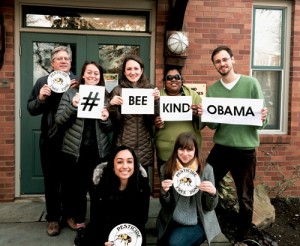
As the pollinator crisis continues this holiday season, groups and concerned citizens across the country are calling on the President to #BeeKindObama, and give the gift of pollinator protection by making certain the Pollinator Health Task Force takes decisive action on bee-harming pesticides.
Other countries are following the science and directly addressing the threat that neonics pose to pollinators. Over a year ago, the European Union’s suspension of neonics went into effect. And just recently the government of Ontario announced plans to reduce the use of neonic-treated seeds by 80%. Pollinators in the United States can’t wait any longer, so we’re taking our request directly to the President and urging him to ensure the U.S. takes similar steps to protect pollinators!
Take Action
Can you help pollinators this holiday season by asking the President to #BeeKindObama and suspend bee-toxic neonics?
Joining the online action is easy:
 1) Write out the hashtag #BeeKindObama on a sheet of paper, whiteboard, or print out the shareable bee image to the right.
1) Write out the hashtag #BeeKindObama on a sheet of paper, whiteboard, or print out the shareable bee image to the right.
2) Take a photo of yourself with the hashtag, asking the President to #BeekindObama and suspend harmful neonic pesticides.
3) Upload the photo to social media (Facebook or Twitter)
4) Tweet or post to @BarackObama or @WhiteHouse, and be sure to include the hashtag #BeeKindObama!
Get creative with your picture!
If you’re a beekeeper or have a friend who is, take the picture in front of your winterized hive with your beekeeping suit on. Or, dust off your Halloween honey bee costume! You could also show off the local honey you’ve purchased in your photo ”” anything that shows your appreciation for the critical services pollinators provide.
Sample Tweets
Here are a few sample tweets you can use with your photo (click to tweet!):
Ӣ President @BarackObama: Why are bees still waiting for protections from harmful #neonics? #BeeKindObama
Ӣ President @BarackObama: Take action to suspend bee-toxic neonic pesticides! #BeeKindObama
”¢ 1in3 bites of food need pollinators but they’re threatened by toxic neonics.@BarackObama will you help? #BeeKindObama
Sample Facebook post
Copy and paste below and send to www.facebook.com/barackobama or www.facebook.com/WhiteHouse:
President Obama, please ensure the Pollinator Health Task Force takes swift and meaningful action on bee-harming neonic pesticides. We rely on bees for 1 in 3 bites of food we eat, but they’re in trouble. Other countries are following the science and directly addressing the threat neonics pose to pollinators. Over a year ago, the European Union’s suspension of neonics went into effect. And just recently the government of Ontario announced plans to reduce the use of neonic-treated seeds by 80%. Pollinators in the United States can’t wait any longer. Please #BeeKindObama and suspend neonic pesticides!
We hope our staff photo above will inspire you to take action and ask the President to #BeeKindObama!
Thank you for participating in this important campaign! For more information on Beyond Pesticides efforts and how you can take action to protect honey bees and other wild pollinators, see the BEE Protective webpage.
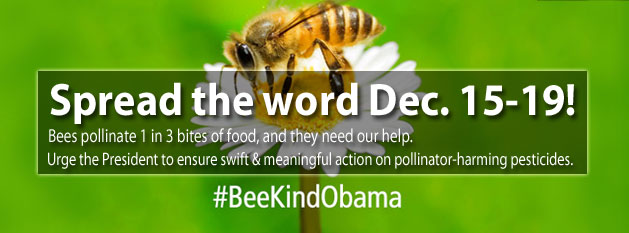
All unattributed positions and opinions in this piece are those of Beyond Pesticides.
Posted in Announcements, Chemicals, neonicotinoids, Pollinators, Take Action by: Beyond Pesticides
2 Comments
12
Dec
(Beyond Pesticides, December 12, 2014) Bursting at the seams, the $35 billion organic food industry has tripled in size over the past decade, severely outpacing the U.S. Department of Agriculture’s (USDA) ability to monitor the more than 25,000 farms and other organizations that sell organic crops and livestock. As a result, certifying agents, or USDA-accredited entities that inspect and certify organic farms and suppliers, have increasingly fallen out of compliance, according to a piece in the Wall Street Journal. Advocates point out that while improvements should be made  in the organic certification system, there is no equivalent inspection system in chemical-intensive agriculture, where inspections are mostly complaint-driven, infrequent, and conducted in most states by state departments of agriculture, which typically promote pesticides and have suffered declines in resources and inspectors.
 There are currently 81 accredited certifying agents, which include small nonprofit groups, state-run agencies, and large multinationals. However, according to an internal USDA report, of the 37 that had a complete review this year, 23 were cited for failing to correctly enforce certification requirements on farms in audits. These 23 firms did not manage to properly conduct onsite inspections or correctly review applications for organic certifications, among other things, the report added.
There are currently 81 accredited certifying agents, which include small nonprofit groups, state-run agencies, and large multinationals. However, according to an internal USDA report, of the 37 that had a complete review this year, 23 were cited for failing to correctly enforce certification requirements on farms in audits. These 23 firms did not manage to properly conduct onsite inspections or correctly review applications for organic certifications, among other things, the report added.
Consumers must rely on certifiers to uphold the integrity of the USDA organic label and to ensure that the food they buy is produced in accordance with  guidelines set forth by the federal government.
A separate Wall Street Journal investigation of USDA inspection records since 2005 found that 38 of the 81 certifying agents failed at least once to uphold basic USDA standards. In that time, 40% of the 81 certifiers have been flagged by USDA for conducting incomplete inspections; 16% of certifiers failed to cite organic farms’ potential use of banned pesticides and antibiotics; and 5% failed to prevent potential mixing of organic and non-organic products.
USDA responded to the Journal’s findings by saying that it requires certifiers to comply with numerous requirements, and the problems found by the Journal and the agency’s internal report reflected “a very rigorous accreditation process that requires full compliance and correction of identified issues.” Certifiers that fall out of compliance get the opportunity to rectify the problem, but if the problem is not fixed, they are at risk of being removed from the certification program.
USDA added that its certifiers were in compliance with 97% of its regulations. According to a USDA spokesman, three agents have been removed from the certifying business by USDA out of the 100 that have been accredited to operate since the start of the program in 2002.
One instance, in 2010, found the California Organic  Farmers Association’s (COFA) accreditation as an organic certifying agent revoked because it failed to comply with the national organic regulations. As a result, COFA  was no longer authorized by USDA’s National Organic Program  (NOP) to certify organic crop, livestock, wild crop, and handling operations. Although the rigorous standards and certification procedures of the NOP are unparalleled in chemical-intensive agriculture, the program has been criticized for straying from its legal requirements during the Bush Administration. Organic advocates applaud NOP’s renewed commitment to organic integrity.
NOP accredited COFA as an organic certifying agent on April 29, 2002. Following COFA’s submission of a 5-year renewal application in 2007, NOP conducted an audit of the facility and its records, which resulted in the finding of 12 noncompliant items. After COFA submitted corrective actions, NOP determined that COFA had not adequately corrected 10 of the noncompliance infractions. On July 31, 2008, the NOP proposed to revoke COFA’s accreditation for three years due to failure to comply with the NOP regulations or to proffer satisfactory corrective actions. COFA appealed the NOP’s decision, which the Agricultural Marketing Service Administrator denied Oct. 8, 2009. Pursuant to federal regulations, COFA requested a formal administrative proceeding before an administrative law judge. In August 2010, COFA withdrew its request for a hearing, thereby upholding the Administrator’s denial of COFA’s appeal and revoking COFA’s accreditation for 3 years.
COFA’s noncompliance with the governing act and the national organic standards included review of a facility in which an employee held a partial interest, inadequate retention of records and procedures, and insufficient inspections of and communication with certified operations.
“We use the full set of enforcement tools that we have available to us, while also working with the legal parameters of the administrative law system,” a USDA spokesman said. “Any issues of noncompliance, however minor, are corrected.”
Some critics disagree with this. “The whole setup of the system needs to be revamped,” said Chenglin Liu, a professor of law at St. Mary’s University in San Antonio, who has studied the organic certification system and has raised concerns about the thoroughness of certifying agents and the lack of frequent checks by the USDA of these certifiers. “That leaves a lot of room for mistakes.”
With more and more American eating organic it is important to take action to ensure a  strong organic program and increase public trust in the organic food label. Visit  Beyond Pesticides’  Save Our Organics  page for information on what you can do to secure an organic future. To learn more about the environmental and worker benefits of organic production, see  Beyond Pesticides’  Eating with a Conscience.
Source: Wall Street Journal
All unattributed positions and opinions in this piece are those of Beyond Pesticides.
Posted in Agriculture, Alternatives/Organics, Announcements, National Organic Standards Board/National Organic Program, Take Action by: Beyond Pesticides
No Comments
11
Dec
(Beyond Pesticides, December 11, 2014) A new study out of the University of California, Berkeley, compares organic and conventional crop yields and finds that overall yield gaps are much smaller than earlier studies concluded and even smaller when compared crop-by-crop. The study, Â published in the Royal Society Proceedings B journal, Diversification practices reduce organic to conventional yield gap, also found that certain practices could further shrink the productivity gap where it exists.
 The debate surrounding organic crop yield capabilities has been a heated one, with agribusiness and conventional farming advocates claiming that pesticides and genetically-engineered (GE) crops are necessary to feed the ever-expanding world population. These interests usually dismiss organic agriculture’s ability to provide the necessary amount of crops to achieve the end goal of feeding the world.
The debate surrounding organic crop yield capabilities has been a heated one, with agribusiness and conventional farming advocates claiming that pesticides and genetically-engineered (GE) crops are necessary to feed the ever-expanding world population. These interests usually dismiss organic agriculture’s ability to provide the necessary amount of crops to achieve the end goal of feeding the world.
Numerous studies have previously undercut this premise, finding similar yields and greater economic returns in organic agriculture and determining GE crop yield abilities to be mostly unfounded. Recently, even the U.S. Environmental Protection Agency (EPA) called into question the efficacy and crop-yield outputs of soybean seeds pre-coated with the dangerous and pollinator-toxic pesticides of neonicotinoids.
The current study’s researchers  wanted to examine this hotly debated issue and take a look at a newly compiled and expanded set of data nearly three times larger than those previously used (115 studies containing more than 1000 observations). Additionally, the study used a new hierarchical analytical framework that would better be able to account for the heterogeneity and structure in the data.
The findings were encouraging for organic advocates, showing an overall crop yield difference of 19.2 percent between conventional and organic outputs. When looking at specific crops, such as legumes (lentils, beans, etc.), no significant differences were identified. Researchers also noted that the percentages were likely inflated, as available studies comparing farming methods were often biased in favor of conventional agriculture.
But the study also took one more step and analyzed whether or not organic farming could do better through agricultural diversification practices, otherwise known as multi-cropping and crop rotations. The answer was a resounding, “Yes,” showing that the crop yield difference could be reduced by 9 percent in the case of multi-cropping and 8 percent in the case of crop rotations.
“In terms of comparing productivity among the two techniques, this paper sets the record straight on the comparison between organic and conventional agriculture,” said the study’s senior author, Claire Kremen, Ph.D., professor of environmental science, policy and management and co-director of the Berkeley Food Institute. “With global food needs predicted to greatly increase in the next 50 years, it’s critical to look more closely at organic farming, because aside from the environmental impacts of industrial agriculture, the ability of synthetic fertilizers to increase crop yields has been declining.”
To put the chemical-intensive food  global food production in perspective, the study’s introduction states: “Resultant problems include biodiversity loss, massive soil erosion and degradation, eutrophication and oceanic dead zones, pesticide effects on humans and wildlife, greenhouse gas emissions, and regime shifts in hydrological cycling. Furthermore, although agriculture produces a food surplus at the global scale, over 1 billion people are chronically hungry. These problems of hunger, food insecurity and environmental harms will only be exacerbated if current trends in population growth, food and energy consumption, and food waste continue. To maintain the Earth’s capacity to produce food, it is imperative that we adopt sustainable and resilient agricultural practices as soon as possible.”
Organic agriculture has been proven time again to be equally viable for both farmers and consumers while also providing significant health and environmental effects over conventional industrial agriculture. Visit Beyond Pesticides’ Keep Organic Strong webpage to learn more about organic and what you can do to support its growth.
All unattributed positions and opinions in this piece are those of Beyond Pesticides.
Sources: UC Berkeley; The Independent
Posted in Agriculture, Alternatives/Organics, California, Genetic Engineering, State/Local, Take Action by: Beyond Pesticides
1 Comment
10
Dec
(Beyond Pesticides, December 10, 2014) Emmanuel Giboulot, an organic winemaker in Burgundy, France, cheered ‘victory for people power’ after his conviction for refusing to spray his vines with pesticides was overturned. Mr. Giboulot refused to comply with a government order mandating vineyards be sprayed to control flavescence dorĂ©e disease, citing that it was not an immediate threat in his region, and that pesticides posed more harm than good. His resolve against systemic, prophylactic pesticide spraying won broad support across the globe.
 In the spring of 2013, all wine producers in Burgundy were ordered to spray pesticides on their vines to fight flavescence dorĂ©e, a bacterial disease spread by the leaf hopper, Scaphoideus titanus. But Mr. Giboulot produces high-quality organic or “bio-dynamic” red and white wines from 35 acres of vines under the appellations “CĂ´te de Beaune” and “Haute CĂ´te de Nuits.” He refused to obey the pesticide order on the grounds that the disease was not an immediate threat in his region, the pesticide recommended to be sprayed was ineffective and damaging to pollinating insects such as bees, and the disease can be fought via more natural means. After defying an official order to treat his vineyard, Mr. Giboulot was fined €1,000 and risked six months in jail.
In the spring of 2013, all wine producers in Burgundy were ordered to spray pesticides on their vines to fight flavescence dorĂ©e, a bacterial disease spread by the leaf hopper, Scaphoideus titanus. But Mr. Giboulot produces high-quality organic or “bio-dynamic” red and white wines from 35 acres of vines under the appellations “CĂ´te de Beaune” and “Haute CĂ´te de Nuits.” He refused to obey the pesticide order on the grounds that the disease was not an immediate threat in his region, the pesticide recommended to be sprayed was ineffective and damaging to pollinating insects such as bees, and the disease can be fought via more natural means. After defying an official order to treat his vineyard, Mr. Giboulot was fined €1,000 and risked six months in jail.
On appeal, the court in Dijon found in Mr. Giboulot’s favour. The court ruled that it was the local government administrator who had acted illegally by ordering all Burgundian vineyards to be sprayed when there was no clear threat. The court also ruled that the local agricultural board and administrator failed to seek the approval of the ministry of agriculture in Paris.
“This is a victory for people power and for whistleblowing,” Mr. Giboulot said of his stand, which divided the Burgundy wine industry but won admiration all over the globe.
He was supported by some of his fellow wine-producers, but others accused him of placing the whole of the Burgundy vineyards —among the most prestigious in the world— at risk. Mr. Giboulot said he would be ready to use a  pesticide against an immediate threat, but the “knee-jerk” and “systematic” use of chemicals was bad for human health, and bad for the quality of wine. The leaf-hopping insect Scaphoideus titanus, which spreads flavesence dorĂ©e (or “golden rot”), has been compared to phylloxera, the pest which devastated French vineyards in the 19th century. An estimated 30 acres of vines were destroyed by the disease in 2012. The French agriculture ministry prosecuted Mr. Giboulot in 2013 for “failing to apply an insecticide treatment to his vineyard.” Vine growers in several regions, including Burgandy, are required by French law to use pesticides to control this disease. After initial discovery of the disease in Burgundy’s Beaune region, the local administration ordered all vineyard owners in the CĂ´te d’Or area to treat their vineyards with pesticides. But Mr. Giboulot argued that the pyrethrin-based pesticide product that organic farmers could use against the pest without losing their certification has undesirable side effects on non-target organisms.
Golden rot had appeared in only 16 villages in the whole of CĂ´te d’Or —and not in Mr. Giboulot’s own part of the county, the CĂ´te de Beaune. “This is proof that we are not faced by a pandemic and there was no need to spray the whole dĂ©partement,” he said.
 Mr. Giboulot is part of a gathering movement that says the French wine industry’s excessive use of pesticides and fungicides has undermined its own argument that good or great wine can only flow from “terroir” —or natural conditions of soil or climate. An examination of 300 French wines last year found that 90 per cent contained traces of the chemicals most commonly used to treat vines. Thirty-three chemicals found in fungicides, insecticides, and herbicides showed up in wines, and every wine showed some detectable trace of chemicals. (The study can be found here in French.) France is the third-highest user of pesticides in the world after the United States and Japan, and the highest user in Europe. The country has pledged to reduce its pesticide consumption by 50 percent by 2018.
Mr. Giboulot is part of a gathering movement that says the French wine industry’s excessive use of pesticides and fungicides has undermined its own argument that good or great wine can only flow from “terroir” —or natural conditions of soil or climate. An examination of 300 French wines last year found that 90 per cent contained traces of the chemicals most commonly used to treat vines. Thirty-three chemicals found in fungicides, insecticides, and herbicides showed up in wines, and every wine showed some detectable trace of chemicals. (The study can be found here in French.) France is the third-highest user of pesticides in the world after the United States and Japan, and the highest user in Europe. The country has pledged to reduce its pesticide consumption by 50 percent by 2018.
The organic wine market has grown —the share of organically produced French wines rose from 2.6 percent in 2007 to 8.2 percent by the end of 2012. According to the New York Times, contamination of organic vineyards from neighboring areas continues to threaten the industry. In the U.S., only wine made with organic grapes and naturally occurring sulfites can be labeled organic.
Source: The Independent
Photo Sources: Jeff Pachoud/AFP/Getty Images
All unattributed positions and opinions in this piece are those of Beyond Pesticides.
Posted in Agriculture, Alternatives/Organics, Chemicals, International, Litigation, Pyrethrin by: Beyond Pesticides
1 Comment
09
Dec
(Beyond Pesticides, December 9, 2014) Food and Drug Administration (FDA) Â proposed updates to rules under the Food Safety Modernization Act (FSMA) are unnecessarily burdensome for local, organic farmers and undermine the ultimate goal of improving food safety, according to food safety advocates. Although FDA adopted some recommendations addressing smaller scale and organic farm concerns made during the last public comment period for these rules, further action is needed.
 Tell FDA to protect small, organic farmers and take steps to avoid chemicals risks. Protecting organic farmers means protecting food safety because organic farmers are in the business of providing food produced with fewer hazards and more care for the environment.
Tell FDA to protect small, organic farmers and take steps to avoid chemicals risks. Protecting organic farmers means protecting food safety because organic farmers are in the business of providing food produced with fewer hazards and more care for the environment.
Despite a recent U.S. Government Accountability Office (GAO) report criticizing FDA for its lack of pesticide residue testing on food, the agency continues to ignore one of the most serious threats to the food supply’s safety and did not address any of the concerns raised in Beyond Pesticides’ previous comments concerning the need to adopt better chemical safety standards for produce and processing.
Regarding chemical safety, FDA should:
- Revise the produce rule and preventative controls for human food rule;
- Include chemical hazards, pesticide residues, and biological impacts in its risk assessments;
- Acknowledge the full range of serious adverse health outcomes from chemical hazards that make their way into food;
- Incorporate procedures, processes, and practices that minimize contamination from chemical hazards; and
- Create explicit and defined practices to help retailers implement least-toxic alternatives.
Organic production methods and standards already provide a functional model. However, proposed revisions to the FSMA rules still place substantial burdens on small, organic farmers.
To protect local, organic farmers, FDA should:
- Decrease the costs to small farms and food processors by ensuring that environmental monitoring and testing are conducted in an efficient manner.
- Clarify that sale and distribution through a CSA, roadside stand, or farmers market is included in the definition of a “retail food establishment,” and not a “facility” that must be registered with FDA.
- Retain the threshold of at least $1,000,000 for a “very small business,” and apply sales to food regulated under the Preventative Controls Rule.
- Allow for farms with multiple landholdings to be treated as one farm, so as to not discriminate against cooperatives or food hubs.
- Incorporate stronger support for on-farm conservation practices by codifying in the preamble that farmers are encouraged to use sustainable conservation practices that enhance food safety.
Submit Your Comment by midnight, December 15th!
Local organic farmers are stewards of the environment and provide some of the only food sources free of the chemical hazards and adverse health effects associated with chemical-intensive agriculture. It is critical that FDA’s FSMA regulations encourage the food safety benefits for  small organic farmers and reduce the burden on those who already make consumer health a priority.
To view FDA’s updated rules, view the federal register notice here.
For additional information, view Beyond Pesticides previous comments to FDA here.
All unattributed positions and opinions in this piece are those of Beyond Pesticides.
Posted in Announcements, Take Action by: Beyond Pesticides
No Comments
08
Dec
(Beyond Pesticides, December 8, 2014) In response to Home Depot’s decision to start requiring all nursery plants that have been treated with neonicotinoids to carry a label to inform customers, at least one nursery supplier has decided to change its management practices. J.Berry Nurseries, a company based out of Grand Saline, Texas, which supplies plants to over 1,000 Home Depot stores throughout Texas, surrounding states and the Midwest, says that since the issue has become publicly recognized for its impacts on bees and other pollinators, it will stop using neonics and start to look at alternative practices. This news provides testament to the power of consumer demand, and along with Beyond Pesticides’ Pollinator-Friendly Seeds and Nursery Directory, should encourage other growers to ditch the neonics in favor of better management practices.
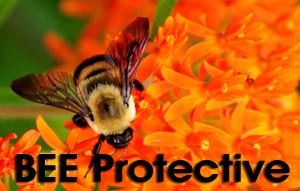 “We view it as the labeling of a plant with that tag is potentially creating customers’ perception that that plant should not be purchased,” Jim Berry, the president of J. Berry Nurseries, told Nursery Management Magazine. “Whether it’s a valid assumption or not, perception is reality. So you have to go with that. We certainly want consumers to be attracted to our plants instead of repelled by them.”
“We view it as the labeling of a plant with that tag is potentially creating customers’ perception that that plant should not be purchased,” Jim Berry, the president of J. Berry Nurseries, told Nursery Management Magazine. “Whether it’s a valid assumption or not, perception is reality. So you have to go with that. We certainly want consumers to be attracted to our plants instead of repelled by them.”
The news comes after a groundbreaking report published last June which revealed that many bee-friendly garden plants sold at Home Depot and Lowe’s contain neonicotinoid pesticides with no warning to consumers. Neonicotinoid residues were detected in seven out of thirteen samples (54 percent) of commercial nursery plants. In response to this report, Friends of the Earth, along  with Beyond Pesticides  and other allies, launched a campaign to tell major retailers to stop selling poisoned plants. Backing the cause are more than half a million Americans who signed petitions demanding that the companies stop selling neonics. In the face of mounting evidence and growing consumer demand, nearly a dozen nurseries, landscaping companies and retailers, are taking steps to eliminate bee-harming pesticides from their garden plants and their stores.
Growers that sell to the Home Depot need to provide a secondary tag for all plant material of all sizes. The tag is a 1” by 4.5” tag, and some growers are concerned about the stigma attached to it. “It’s the cost of the tag and it’s the impact on consumers, maybe causing them to avoid purchasing plants with that tag,” Mr. Berry says. “It’s a double risk.”
Advocates, including Beyond Pesticides, have long called on consumers  to choose not only “bee-friendly” plants, meaning those plants and flowers shown to attract and sustain pollinators, but also  make  sure that those plants are sourced from growers and suppliers that do not apply neonics  in the growing of the seed, as a seed coating, or to the plant.
Neonicotinoid insecticides have been responsible for several high profile bee kills from high doses of the pesticides, but a strong and growing body of science shows that neonics contribute to impairment in reproduction, learning and memory, hive communications, and immune response at doses far below those that cause bee kills. In this study, all of the nursery plant samples where neonics ae detected have the potential to harm or even kill bees. An extensive overview of major studies showing the effects of neonics on pollinator health can be found on Beyond Pesticides’ What the Science Shows webpage.
The easiest way to ensure that seeds are not treated with neonics is to buy seeds that are certified organic or plants grown with organic practices. While untreated seeds are a step in the right direction, they do not ensure that the seed production practices are protective of bees or that residual chemicals do not contaminate the plant. Seeds and plants that are certified organic, on the other hand, do not permit the use of toxic synthetic pesticides, chemical fertilizers, genetically modified organisms, antibiotics, sewage sludge, or irradiation. To assist consumers in making the best choice for pollinator protections, Beyond Pesticides launched its Pollinator-Friendly Seed Directory, a comprehensive list of companies that sell organic seeds to the general public.  Toxic pesticides harmful to bees, including neonics,  are not permitted in  seeds certified organic, which display the USDA Organic label on their packaging. Included in this directory are seeds for vegetables, flowers, and herbs.
Beyond Pesticides urges you and other pollinator supporters to continue to pressure retailers, legislators, and other government officials to take meaningful action to protect pollinators. Visit www.BEE Protective.org to learn about more about pollinator protection and see what you can do to help.
Source: Nursery Management Magazine
All unattributed positions and opinions in this piece are those of Beyond Pesticides.
Posted in Announcements, Chemicals, Corporations, Home Depot, Label Claims, neonicotinoids, Take Action by: Beyond Pesticides
1 Comment
05
Dec
(Beyond Pesticides, December 5, 2014) Over 700 chefs, including high-profile individuals like Tom Colicchio, Jose Andres, Art Smith, and Sam Talbot, are pushing Congress to support labeling of genetically modified foods and oppose efforts blocking state GMO labeling laws. In a petition authored by Chef Tom Colicchio, the chefs are calling on Congress to move forward with legislation sponsored by Senator Barbara Boxer (D-CA) and Representative Peter DeFazio (D-OR),the Genetically Engineered Food Right-to-Know Act,  S. 809  and H.R. 1699, respectively,  which will  require the U.S. Food and Drug Administration (FDA) to “clearly label” genetically engineered (GE) foods.
 “As chefs, we know that choosing the right ingredients is an absolutely critical part of cooking,” the petition states. “But when it comes to whether our ingredients contain genetically modified organisms, we’re in the dark. It’s time for Congress to move us forward, not backward, when it comes to our right to know what’s in our food.”
“As chefs, we know that choosing the right ingredients is an absolutely critical part of cooking,” the petition states. “But when it comes to whether our ingredients contain genetically modified organisms, we’re in the dark. It’s time for Congress to move us forward, not backward, when it comes to our right to know what’s in our food.”
The chefs were joined on Tuesday by advocates from Food Policy Action, Environmental Working Group, and Center for Food Safety. Just Label It!, with which Beyond Pesticides is a partner, and other national organizations fighting for labeling of GMO foods for meetings with lawmakers.
“As a chef and father, I want to  know what I’m serving my customers and kids, and the majority of  Americans want honest information about the food on their tables,” said Chef Colicchio, owner of Craft Restaurants, co-founder of Food Policy Action, and former head judge on Bravo show Top Chef. “Having honest, clear labeling of the foods we eat is a fundamental right, one that’s worth fighting for.”
Across the U.S., grassroots groups are pushing for  the introduction of GE labeling legislation in over 25 states, including Oregon, Colorado, and Vermont. However, a group of legislators, led by Rep. Mike Pompeo (R-KS), are trying to stymie efforts by asking Congress to preempt these laws. H.R. 4432, dubbed the “Deny Americans the Right-to-Know Act” (DARK Act) by activists, is a bill that would give full authority of GE labeling to FDA, which now favors a voluntary approach to the issue.
The DARK Act will  dramatically undermine state  food labeling authority by giving FDA sole authority over the labeling of GE ingredients, preempting state action to label in the face of federal inaction. The act will prevent states from adopting their own GE labeling laws, allow food companies to put a “natural” label on products that contain GE ingredients, and prevent FDA from requiring companies to label GE ingredients and continue its current “voluntary” labeling policy. This codification of a voluntary labeling standard clearly does not meet  consumers growing demand for more information. In the 13 years that FDA has allowed companies to voluntarily label genetically engineered foods, not one company has done so.
Beyond Pesticides believes that consumers have a right to know whether the foods they buy contain GE ingredients, not only because of concerns over the safety of eating GE food, but also because of the direct and indirect effects of GE agriculture on the environment, wildlife, and human health. GE agriculture is associated with the increased use of herbicides that GE crops are developed to tolerate. Repeated spraying of these herbicides, particularly  glyphosate, the active ingredient in Roundup,  destroys refuge areas  for beneficial insects such as the monarch butterfly and  leads to resistance  in the very weed species that GE technology is intended to control. Despite rampant glyphosate resistance, and the presence of organic management practices that are  more protective of human health and the environment, the agrichemical industry continues to resort to increasingly toxic combinations of chemicals.  Recently, the U.S. Environmental Protection Agency (EPA) announced that it has registered Enlist Duo ®, officially approving  the sale and use of a new wave of GE 2,4-D-tolerant crops and their accompanying herbicide formulations.
Buying organically labeled food is one of the best  ways to stop  GE ingredients from being purposely added during food production and handling. Under organic certification standards, GE organisms are prohibited, although because of USDA policies that allow the proliferation of GE crops, organic production is subject to genetic drift contamination.  For this and many other reasons, organic products are the right choice for consumers. For more information on GE foods and labeling issues, see Beyond Pesticides’  Genetic Engineering  webpage. You can also help support the Vermont labeling law by donating to the  Food Fight Fund.
Take Action
Join the Organic Consumers Association for its  rally in Washington, D.C. on Capitol Hill next Wednesday, December 10, to put a stop to the DARK Act. Learn more here.
Can’t make it? You can also:
- Sign a petition  asking Congress to reject Pompeo’s DARK Act  here.
- Help flood the phone lines on Capitol Hill on December 10.  Anyone who can’t be there in person can call their Congress members on December 10, beginning at 9 a.m. When you are connected with a staff person, you can say:  “Hello, my name is [FIRST NAME, LAST NAME] and I live in [CITY, STATE]. I couldn’t attend today’s protest against H.R. 4432, a bill that would preempt states’ rights to label GMOs, but I am calling to ask [NAME OF CONGRESS PERSON] to reject H.R. 4432 and to support states’ rights to pass mandatory GMO labeling laws. Thank you.”
- Make a donation  to help offset costs.
Source: Center for Food Safety
Photo Source: CFS
All unattributed positions and opinions in this piece are those of Beyond Pesticides.
Posted in Agriculture, Announcements, Chemicals, Genetic Engineering, Glyphosate, Labeling, Pollinators, Take Action by: Beyond Pesticides
No Comments
04
Dec
(Beyond Pesticides, December 4, 2014) Earlier this fall, in a state known for its environmental and public health-focused policy and forward thinking, the California Department of Food and Agriculture (CDFA) released its draft Statewide Plant Pest Prevention and Management Program Environmental Impact Report (PEIR), which  has been widely criticized by environmentalists. While PEIR  has been characterized by state officials as  providing an “overarching framework for efficient and proactive implementation of Statewide Program activities,” the proposed plant pest prevention strategy takes several steps backwards, giving CDFA authority to spray toxic pesticides anywhere in California, at any time into the indefinite future, with little to no recourse for those affected.  Critics say that the new framework could have been a tremendous opportunity to chart a course toward sustainable, ecologically, and scientifically, sound pest management policy.
 Under California law, CDFA is required to prevent the introduction and spread of injurious insect or animal pests, plant diseases, and noxious weeds. According to CDFA, to carry out this function, the agency must “provide an up-to-date, transparent, and comprehensive evaluation of CDFA’s activities,” and comply with the environmental impact analysis requirements under the California Environmental Quality Act (CEQA). The statewide program developed the draft PEIR.
Under California law, CDFA is required to prevent the introduction and spread of injurious insect or animal pests, plant diseases, and noxious weeds. According to CDFA, to carry out this function, the agency must “provide an up-to-date, transparent, and comprehensive evaluation of CDFA’s activities,” and comply with the environmental impact analysis requirements under the California Environmental Quality Act (CEQA). The statewide program developed the draft PEIR.
While the overarching goals and objectives of the program include the important concept of minimizing the impacts of pest management approaches on human health and urban and natural environments, most of the draft PEIR took an archaic, vague, and misguided approach to pest control, which identified spraying pesticides with little to no oversight as the primary means of combating pest problems.
Joining with 27 organizations, Beyond Pesticides signed on to Earthjustice’s near 100 page comments, identifying a litany of scientific, public health, environmental, regulatory, and legal issues within the draft PEIR, including a failure to recognize and implement viable alternatives of organic and ecologically-based integrated pest management (IPM) practices, adhere to important environmental laws and controls, like the Clean Water Act, provide detailed and meaningful programmatic evaluation criteria, and address health and environmental impacts.
“This plan’s analysis of health and environmental impacts is so general and cursory as to be useless for determining the actual impact of the Department of Food and Agriculture’s spraying in any specific location in California,” notes Earthjustice Attorney Elizabeth Forsyth, “Its provisions for future environmental review attempt to prevent public scrutiny of future program activities, including the agency’s approval of new pesticides, new treatment areas, and new target pests.”
Organic farmers and certifiers took issue with the PEIR, especially several provisions that could force organic farmers to spray non-organic pesticides as part of the state treatment programs, potentially leading to loss of organic certification and organic crop marketplace accessibility.
Public review and comment on the draft PEIR closed on October 31, 2014 and will be addressed and integrated into the final PEIR, which will be released at a later date. In the meantime, visit Beyond Pesticides website to learn more about the dangers of pesticides and how you and your community can spread the word on organic and least-toxic pest management methods.
All unattributed positions and opinions in this piece are those of Beyond Pesticides.
Source: Earthjustice; California Department of Food and Agriculture
Posted in Announcements, California, Integrated and Organic Pest Management, State/Local, Take Action by: Beyond Pesticides
No Comments
03
Dec
(Beyond Pesticides, December 3, 2014) The U.S. Department of Agriculture (USDA) announced last week that nearly 2,500 applicants will receive disaster assistance through the Emergency Assistance for Livestock, Honey Bees, and Farm-Raised Fish Program (ELAP) for losses suffered from Oct. 1, 2011, through Sept. 30, 2013. The program, re-authorized by the 2014 Farm Bill, provides disaster relief for farmers and producers not covered by other agricultural disaster assistance programs. Beekeepers who reported losses due to colony collapse disorder will be eligible, a move that many in the beekeeping industry welcome.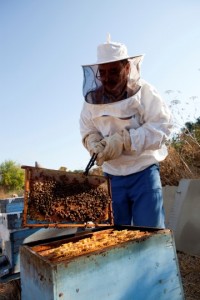
ELAP provides disaster relief to livestock, honey bee, and farm-raised fish producers not covered by other agricultural disaster assistance programs. Eligible losses may include excessive heat or winds, flooding, blizzards, hail, wildfires, lightning strikes, volcanic eruptions, and diseases, or in the case of honey bees, losses due to colony collapse disorder. According to USDA, beekeepers, most of whom suffered honey bee colony losses, represent more than half of ELAP recipients. Enrollment for the program began last spring and ended in August 2014, and eligible farmers, beekeepers and producers must have submitted documentation of losses for enrollment in the program.
Beekeepers have been experiencing historical losses in their bee hives and operations. On average, losses have been over 30% annually, with some beekeepers report 100% losses to their operations. This presents significant ramifications for beekeepers’ livelihoods, crops that rely on pollination and the agricultural economy. Pollination services, provided by bees and other pollinators, are worth billions of dollars to the agricultural economy, given that one in three bites of food is dependent on pollination. Mounting scientific evidence points to the role of pesticides in bee declines across the globe, especially to the neonicotinoid class of insecticides, currently applied to fields across the U.S. as seed treatment. These pesticides have been shown to, even at low levels, impair foraging, navigational and learning behavior in bees, as well as suppress their immune system to point of making them susceptible to pathogens and parasites. Read: No Longer a Big Mystery. Beekeepers have taken legal action against neonicotinoids and other pesticides that have been shown to be highly toxic to bees.
The Farm Bill caps ELAP disaster funding at $20 million per federal fiscal year. To accommodate the number of requests, which exceeded funds available for each of the affected years, payments will be reduced to ensure that all eligible applicants receive a prorated share of assistance. This year over 2,500 applicants are eligible for assistance. USDA stated the agency has begun issuing payments – less than three months after the enrollment deadline.
ELAP is made possible through the 2014 Farm Bill, which according to USDA, builds on historic economic gains in rural America over the past five years, while achieving meaningful reform and billions of dollars in savings for the taxpayer. ELAP assistance is provided for losses not covered by other disaster programs like the Livestock Forage Disaster Program (LFP) and the Livestock Indemnity Program (LIP). Also from USDA, pollinators may find some help in efforts to expand pollinator habitat and forage. The agency announced this fall that more than $4 million in technical and financial assistance will be provided to help farmers and ranchers in the Midwest improve the health of honey bees. The announcement renews and expands on a $3 million pilot investment last spring to create pollinator-friendly habitat in five Midwestern states. According to the agency, it will provide help implementing the planting cover crops or rangeland, pasture management to reduce erosion, increase soil health, and inhibit invasive species, as well as providing quality forage and habitat for honey bees and other pollinators.
Since enactment of the Farm Bill, USDA is tasked with providing disaster relief to farmers and ranchers; strengthening risk management tools; expanding access to rural credit; funding critical research; establishing innovative public-private conservation partnerships; developing new markets for rural-made products; and investing in infrastructure, housing and community facilities to help improve quality of life in rural America.
“As promised, we’re making sure that thousands of producers who suffered through two and a half difficult years without Farm Bill assistance, are getting some relief,” Agriculture Secretary Tom Vilsack said.
2014 Farm Bill and Pollinator Health
After nearly two years of debate, missed deadlines, and Congressional dysfunction, President Obama signed into law on February 7, 2014, the Agricultural Act of 2014, known as the Farm Bill. Passage of the bill was met with mixed reviews on all fronts. While national headlines focused on the issues of supplemental nutrition assistance program (SNAP, or food stamps) cuts, subsidies, and crop insurance, the near 1,000-page law also addressed critical issues relating to health and the environment.
Falling far short of what advocacy groups had hoped would bring much needed scientific attention, funding, and federal regulatory focus on pollinator declines, the final Farm Bill left most pollinator-friendly provisions in the cut pile on the conference committee floor. One amendment in particular, Protection of Honey Bees and Other Pollinators, Â sponsored by Rep. Alcee Hastings (D-Fl), seeks to create a federal task force, requires research, and provides for an allowance for beekeepers to use federal forest lands. The amendment passed in an earlier House version of the Farm Bill by a vote of 270-146 with 79 Republicans and 191 Democrats voting in favor. Â However, this amendment failed to make it into the final version of the bill. The 2014 Farm Bill now only requires interagency collaboration to produce guidance on enhancing pollinator health and long-term viability. Conservation programs that commit to pollinator habitat also receive new preferences. These minor nods to the severe problem facing pollinators lack any true incentives for long-term change or meaningful protections. See here for a comprehensive breakdown of the 2014 Farm Bill.
Even though the U.S. has been slow to act in protecting pollinators from hazardous pesticide use, in spite of the recent Presidential Memorandum directing federal agencies to act, beekeepers can at least now find some financial relief for their losses and hopefully continue to provide the important pollination services that our nation needs.
Source: USDA Press Release
All unattributed positions and opinions in this piece are those of Beyond Pesticides.
Posted in Agriculture, Announcements, National Politics, Pollinators, Wildlife/Endangered Sp. by: Beyond Pesticides
1 Comment
 In 2013, a farmer in Oregon discovered the presence of Monsanto’s original Roundup-Ready wheat, developed to be resistant to glyphosate, in his field despite the company’s plans to abandon the strain and claims to have destroyed the crop  a decade earlier. The company had restarted extensive field trials back in 2011. An investigation by the U.S. Department of Agriculture (USDA) determined that the contamination was an “isolated incident.” It was unable to determine exactly how the wheat came to grow in the Oregon farmer’s field.
In 2013, a farmer in Oregon discovered the presence of Monsanto’s original Roundup-Ready wheat, developed to be resistant to glyphosate, in his field despite the company’s plans to abandon the strain and claims to have destroyed the crop  a decade earlier. The company had restarted extensive field trials back in 2011. An investigation by the U.S. Department of Agriculture (USDA) determined that the contamination was an “isolated incident.” It was unable to determine exactly how the wheat came to grow in the Oregon farmer’s field.
















 Force takes meaningful action and suspends these toxic chemicals. We need your help to continue to put pressure on the POTUS: become active in your community and
Force takes meaningful action and suspends these toxic chemicals. We need your help to continue to put pressure on the POTUS: become active in your community and  What lies ahead: As organic experiences “
What lies ahead: As organic experiences “

 What lies ahead: Activists must remain vigilant by defending and successfully implementing current laws while continuing to push for increased protections. The town of
What lies ahead: Activists must remain vigilant by defending and successfully implementing current laws while continuing to push for increased protections. The town of 


















